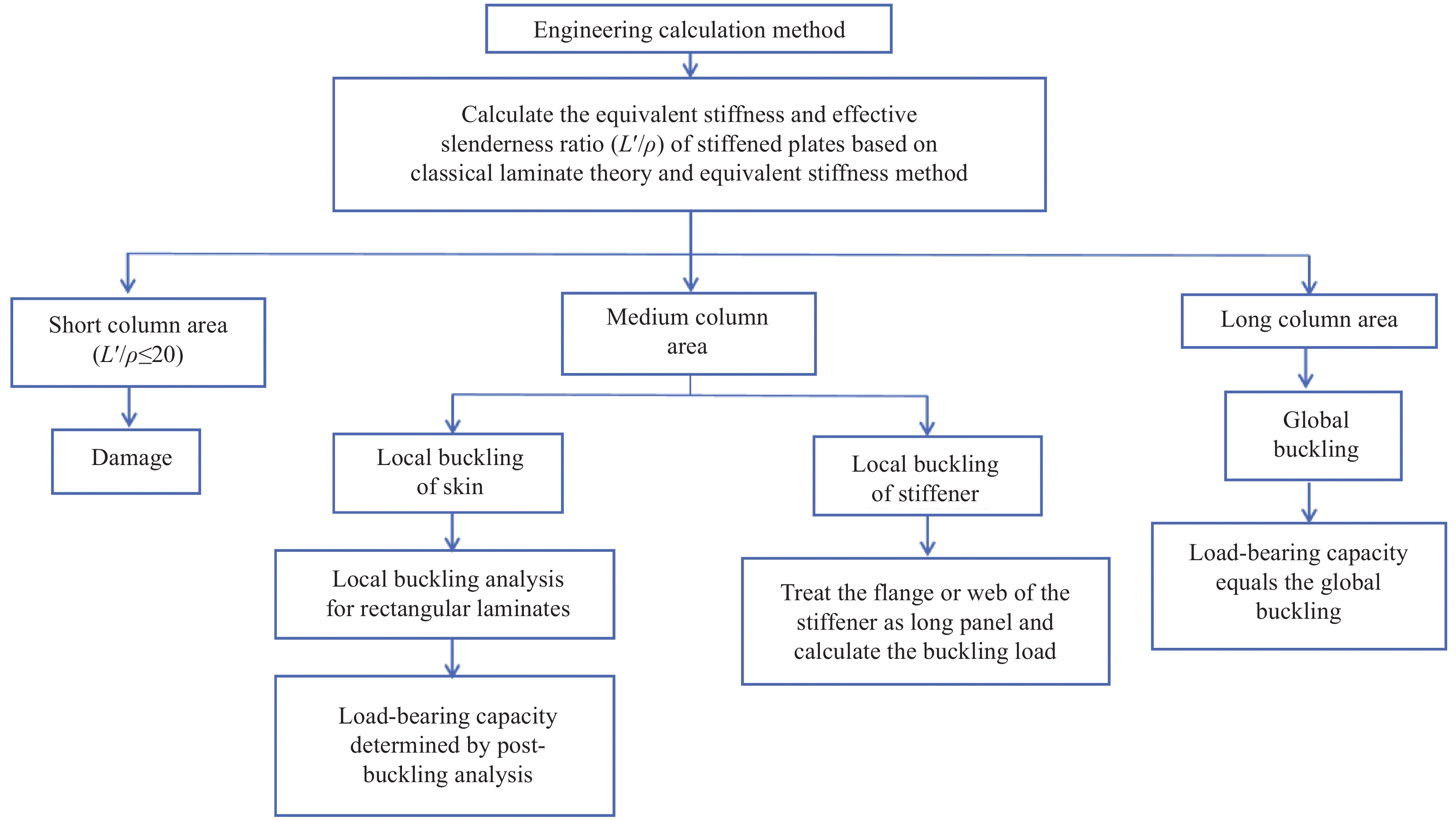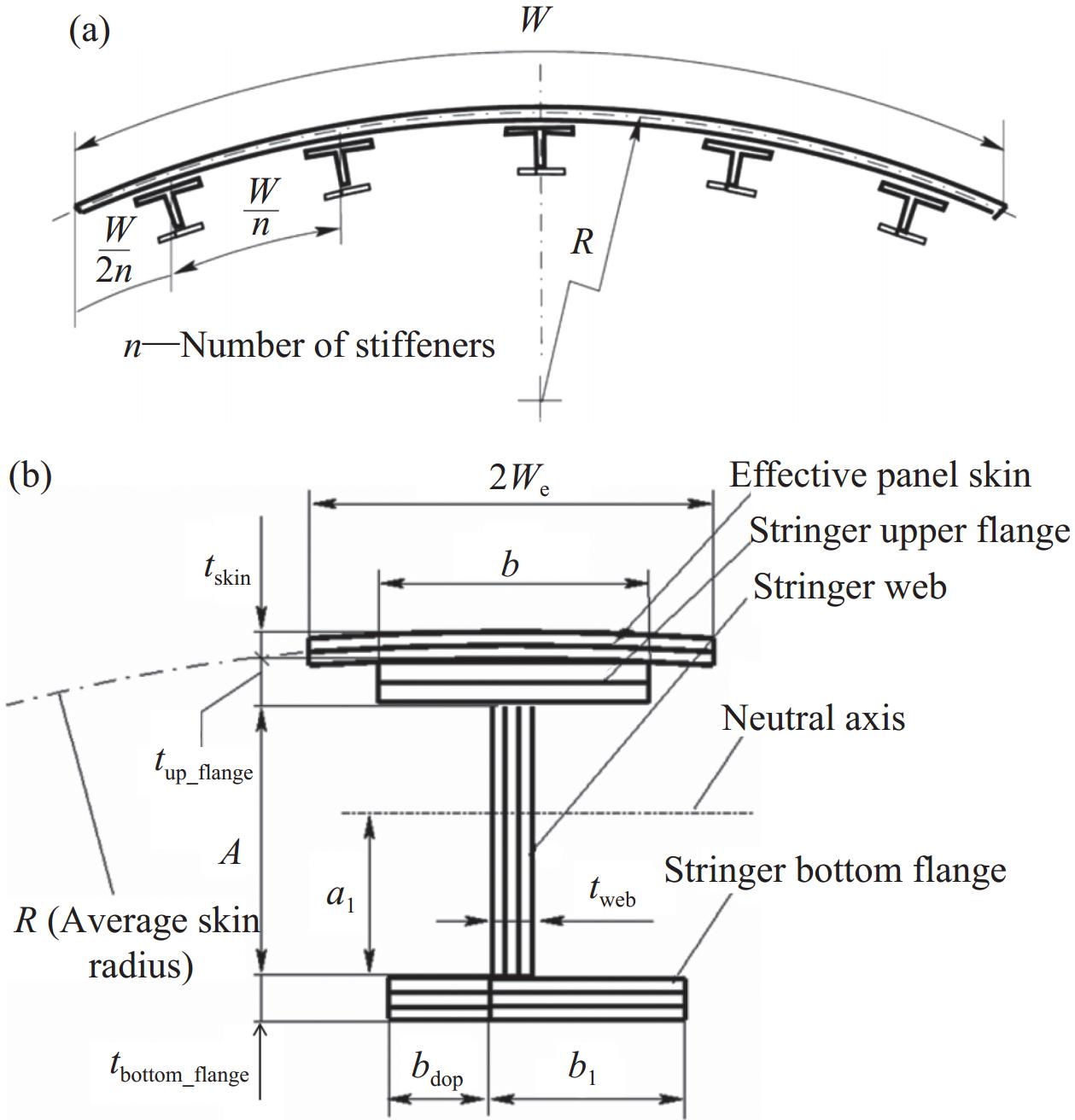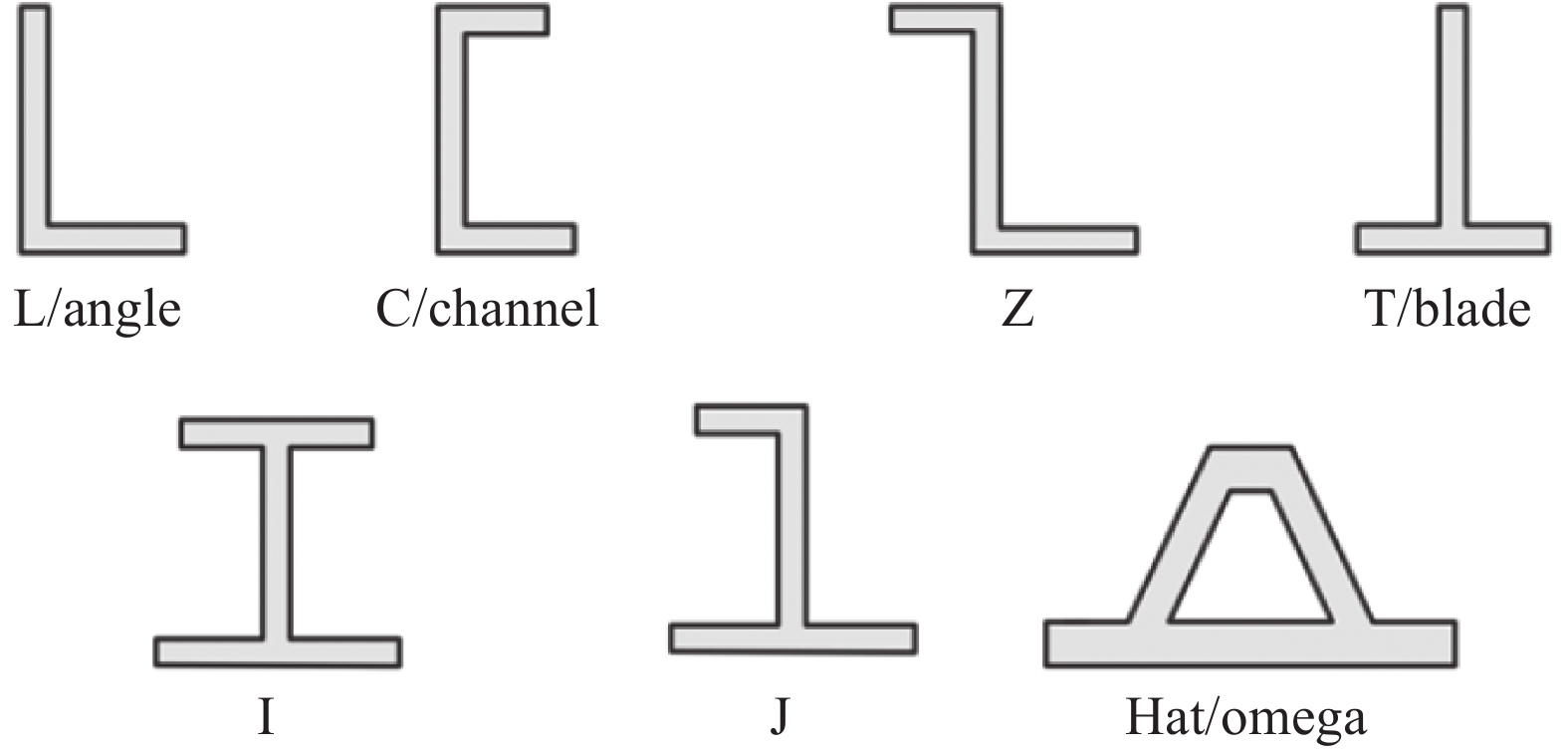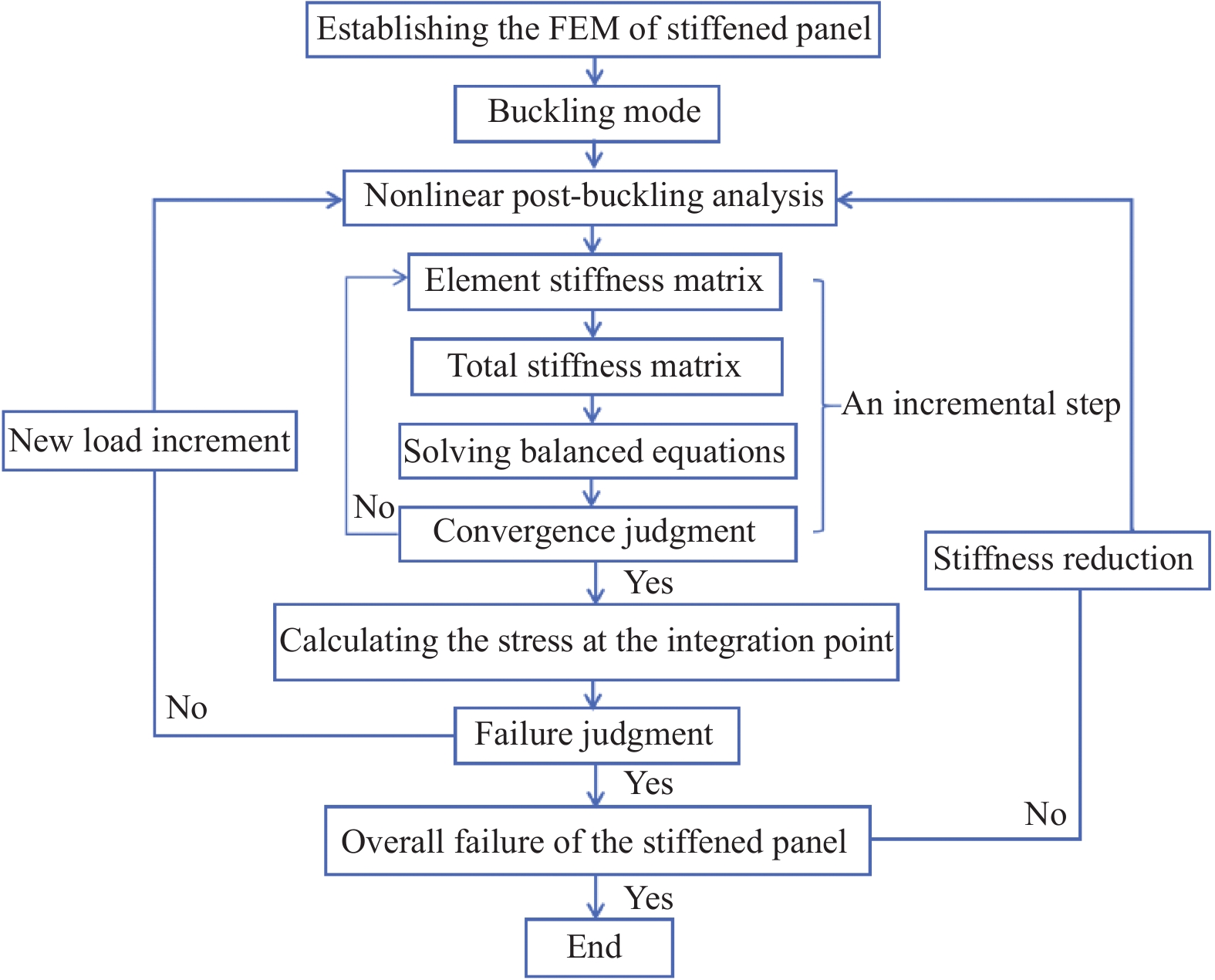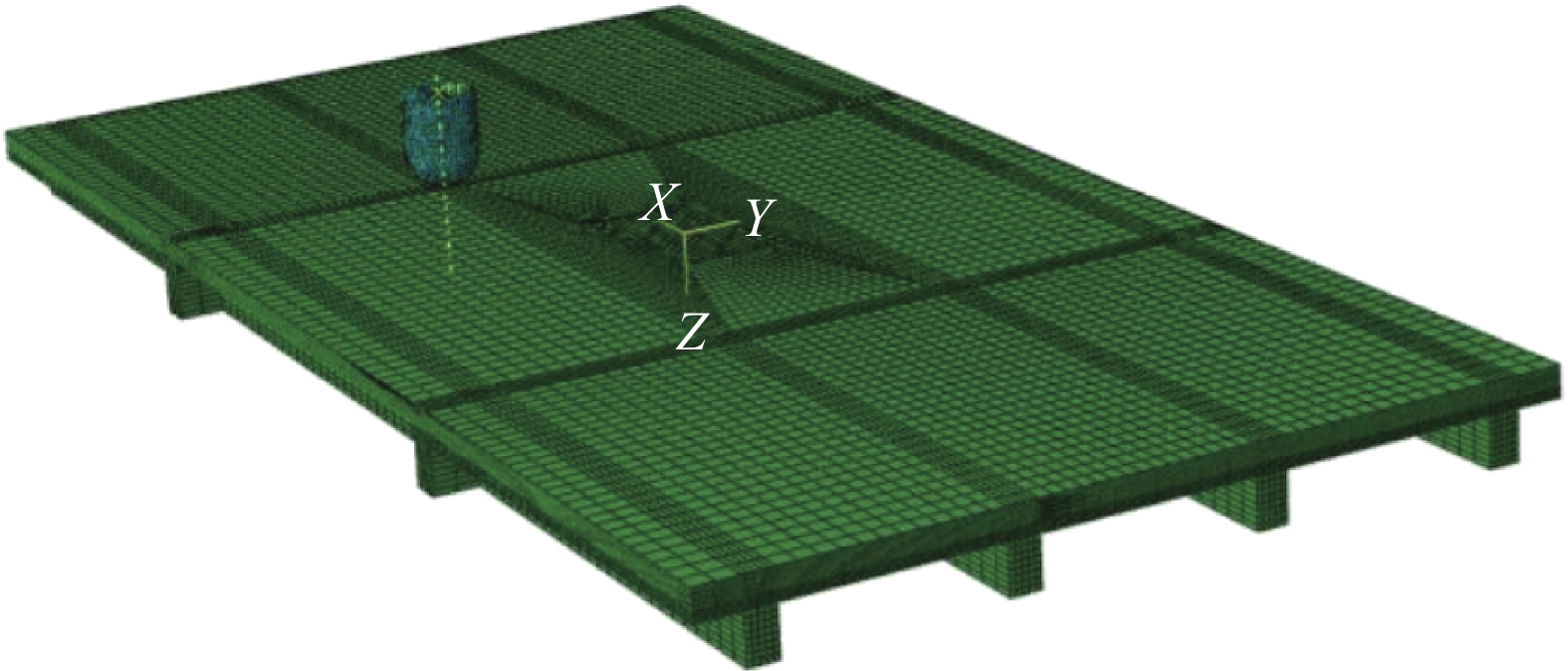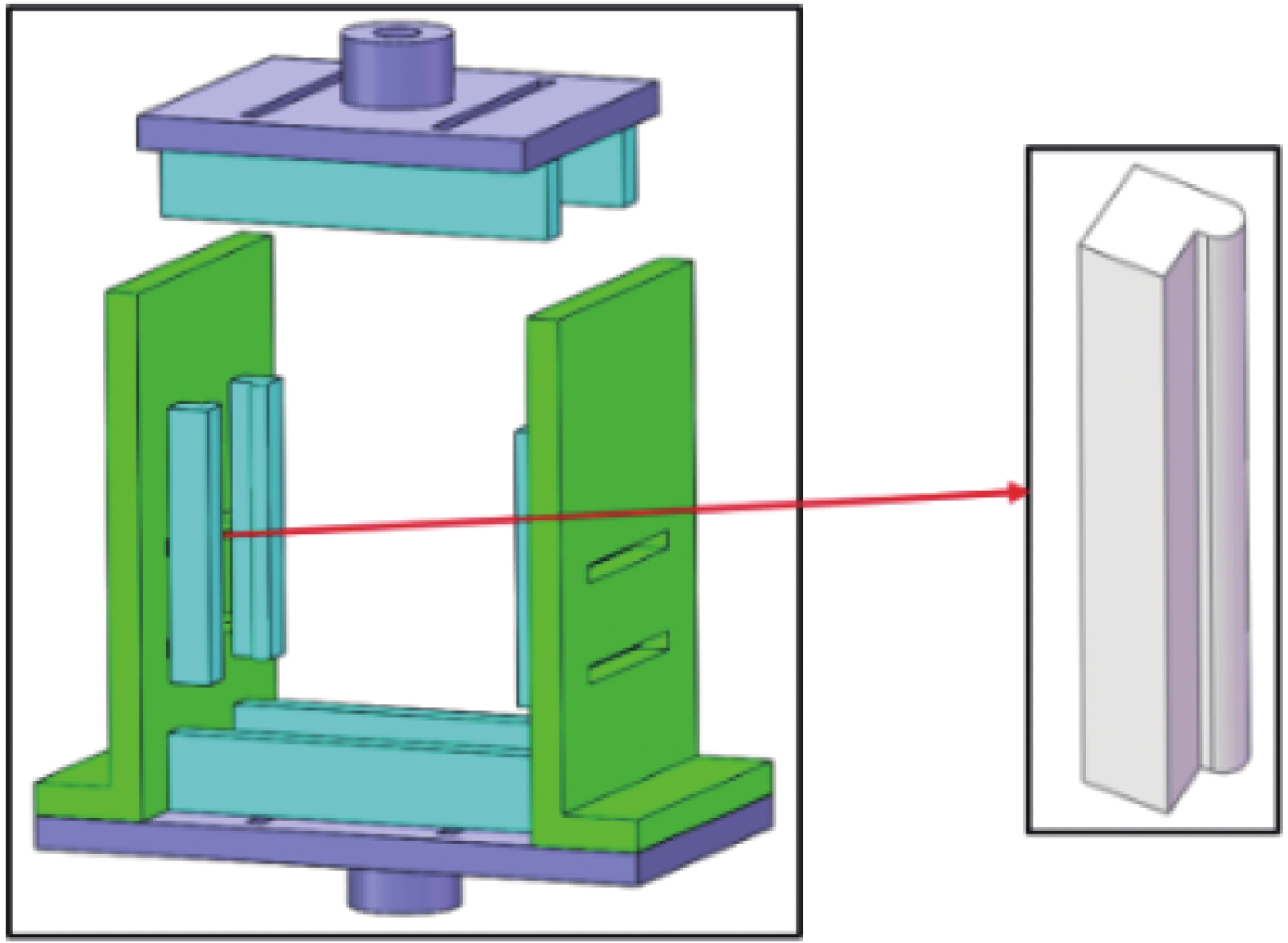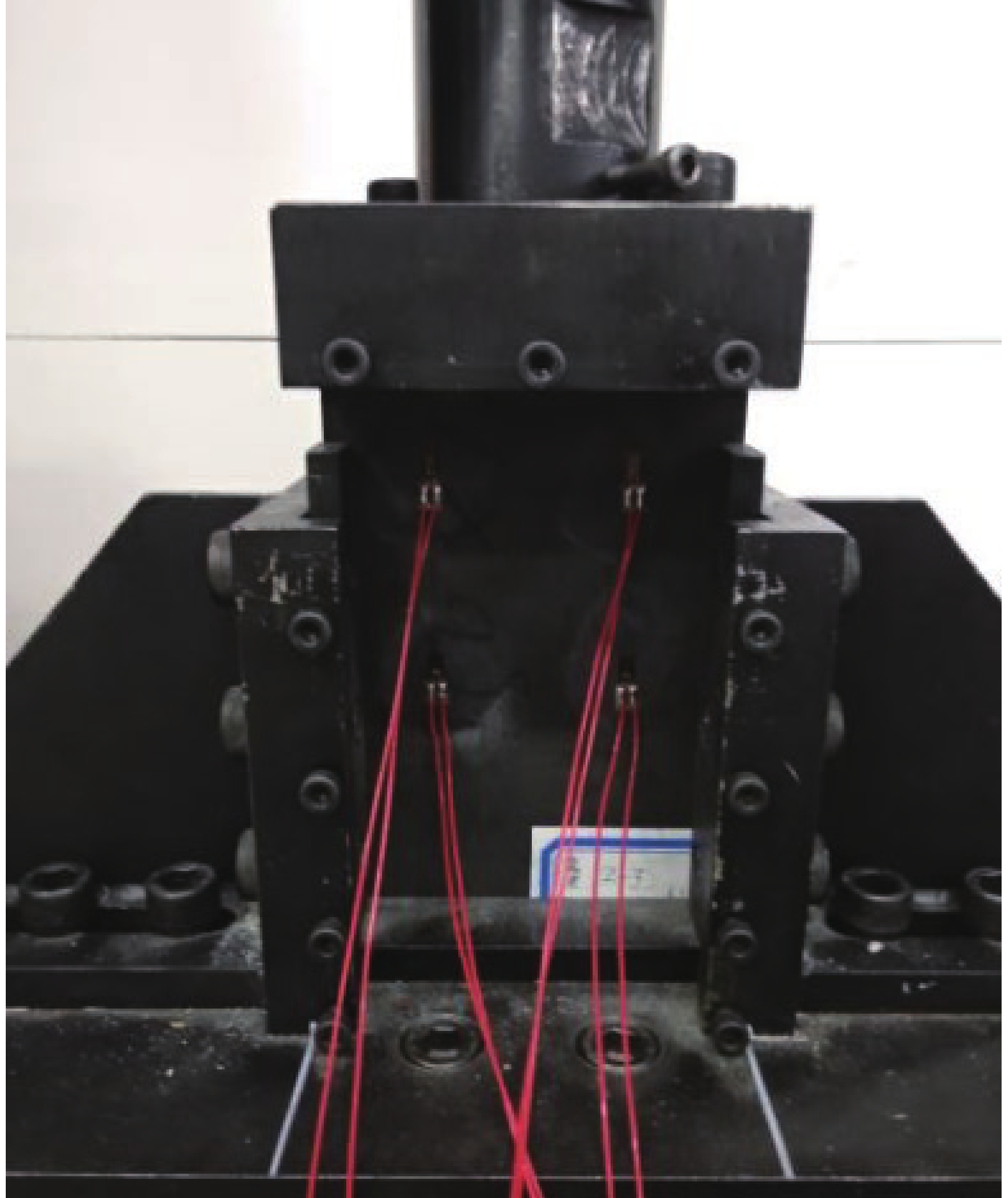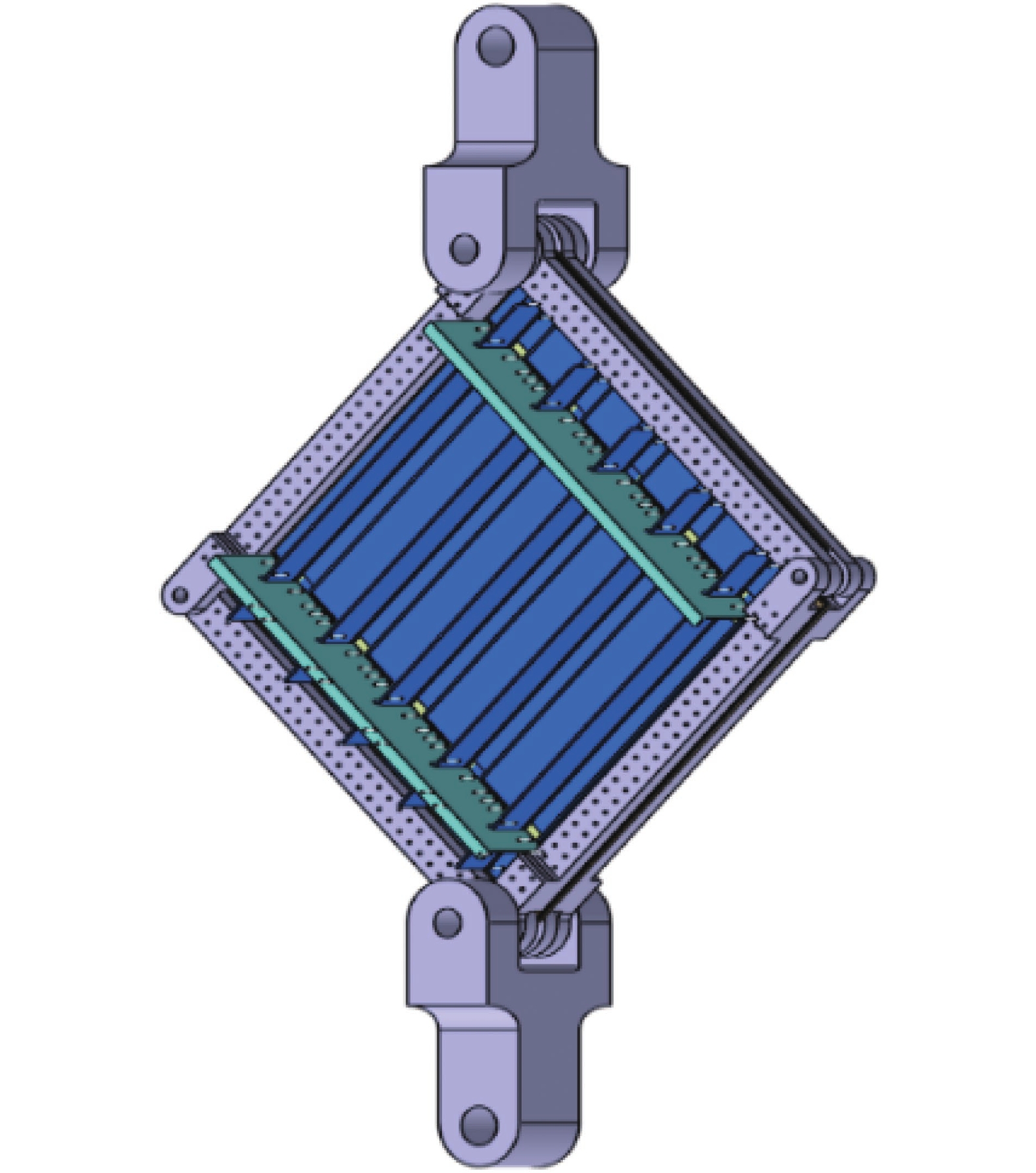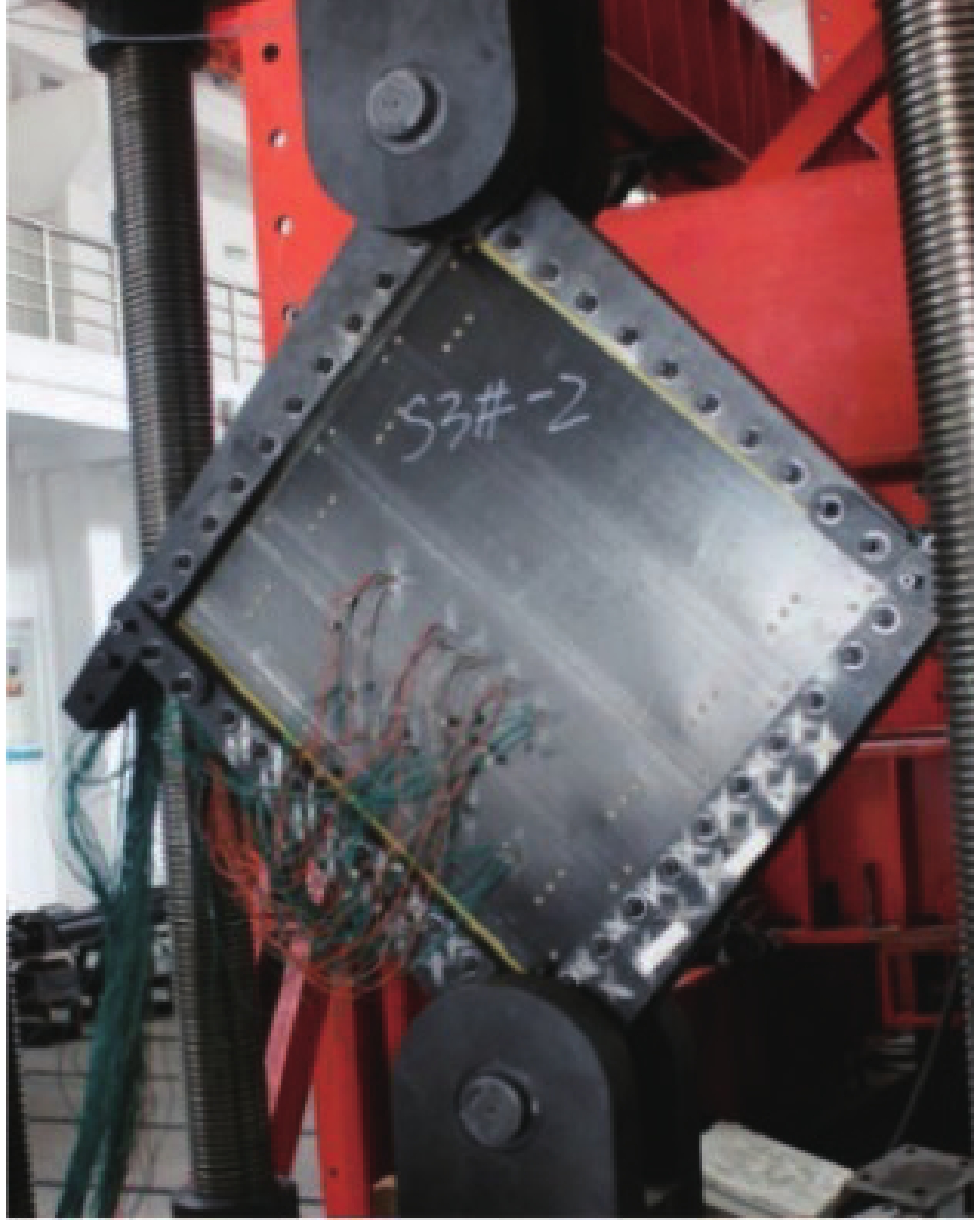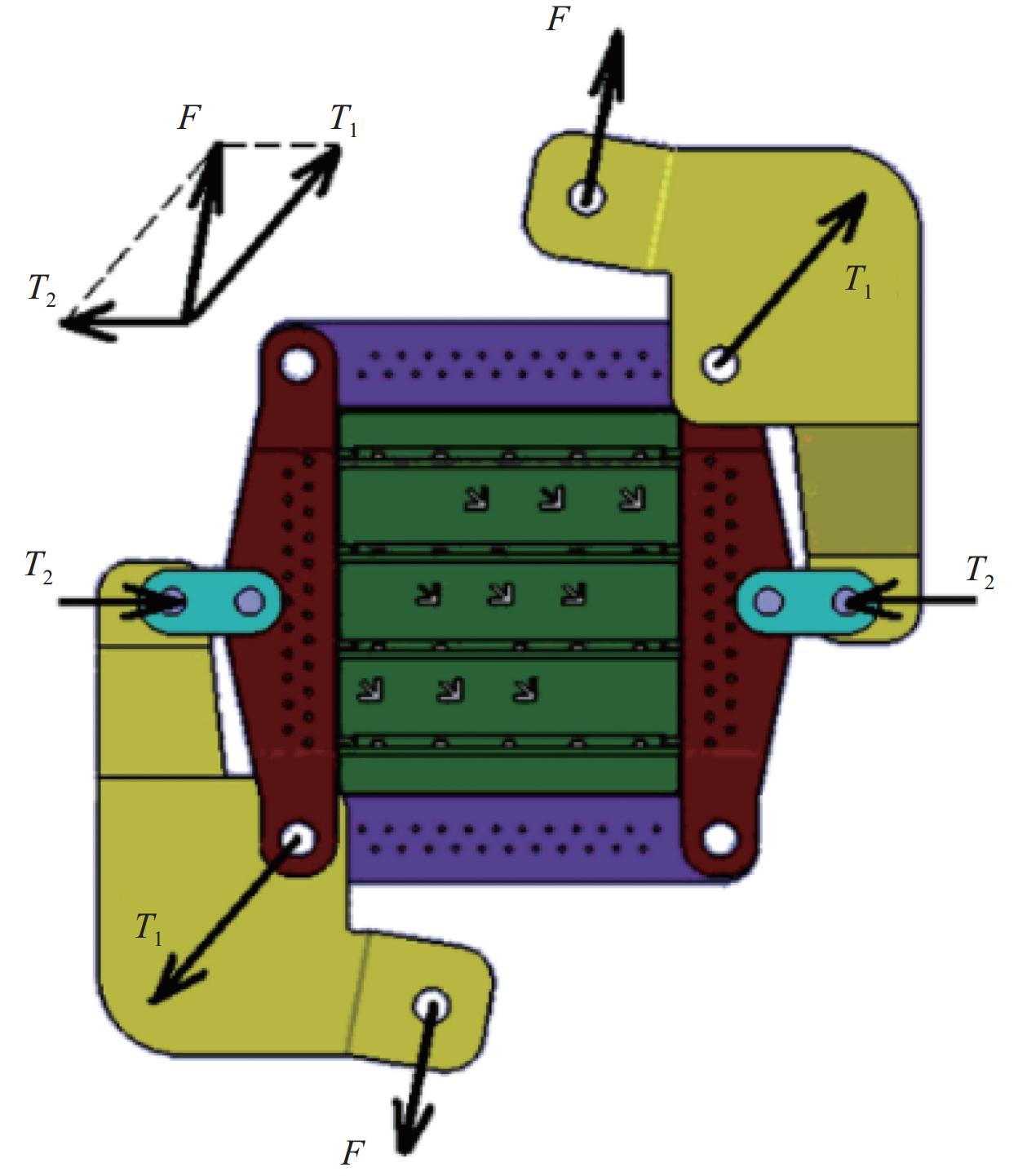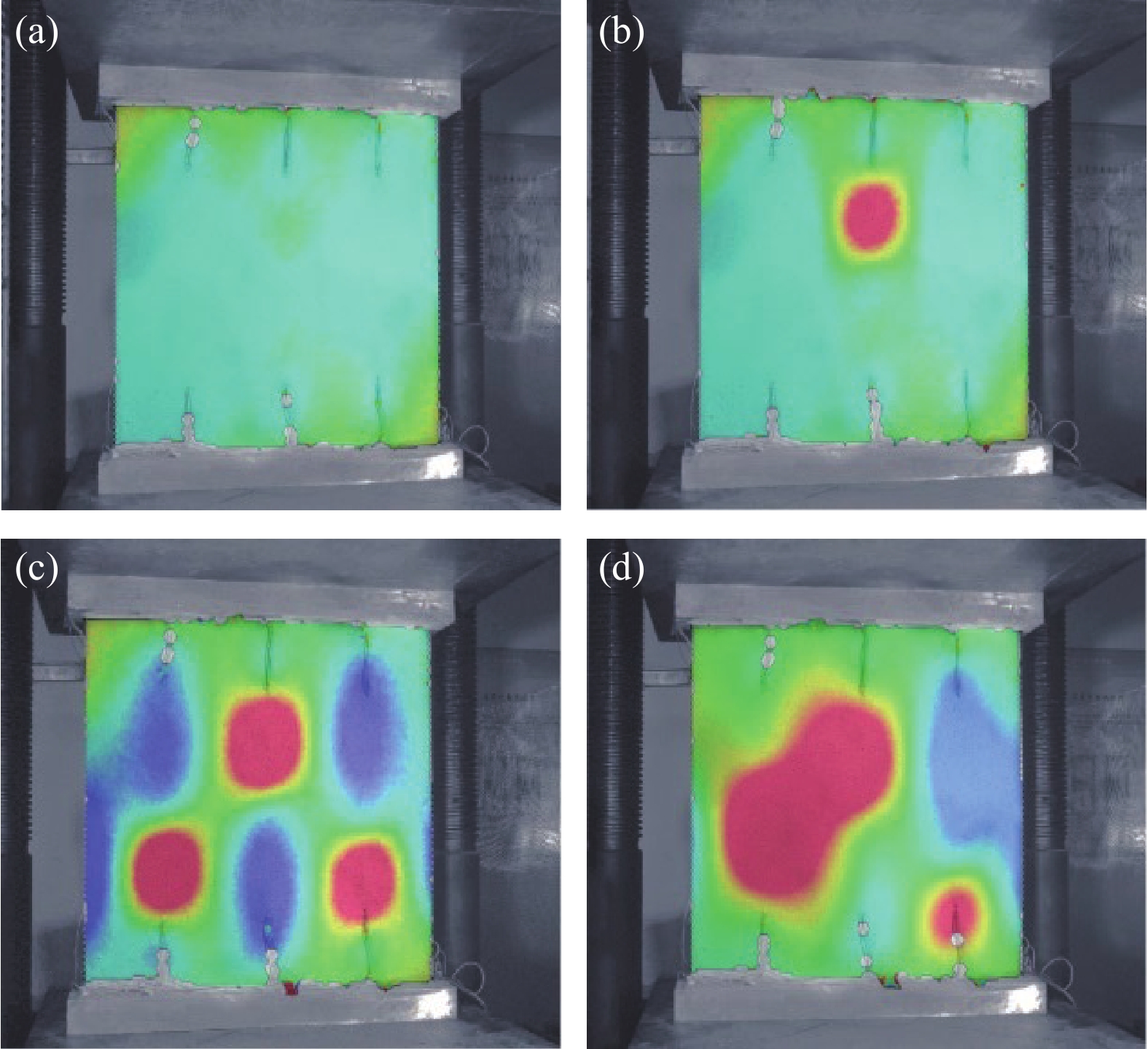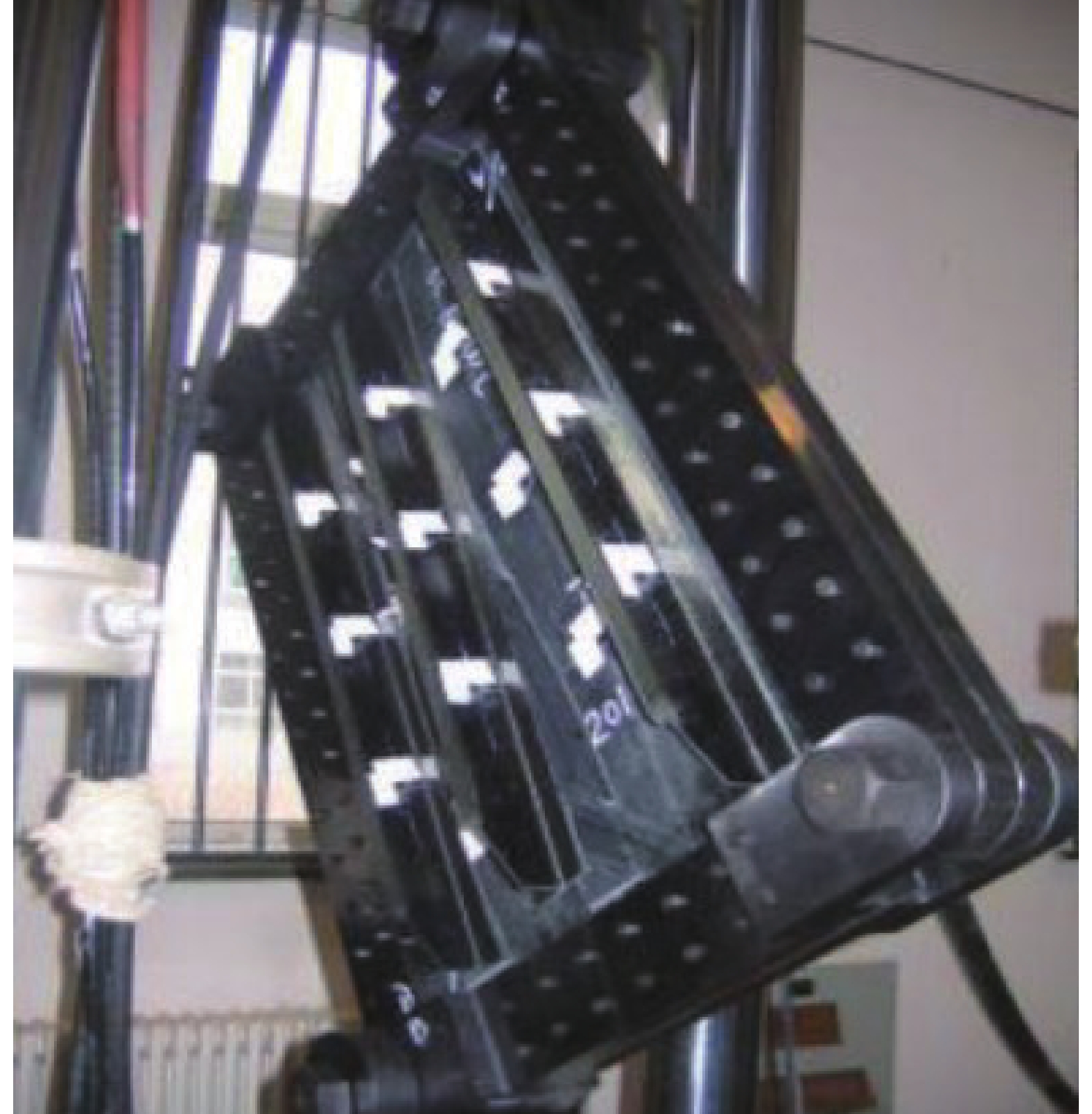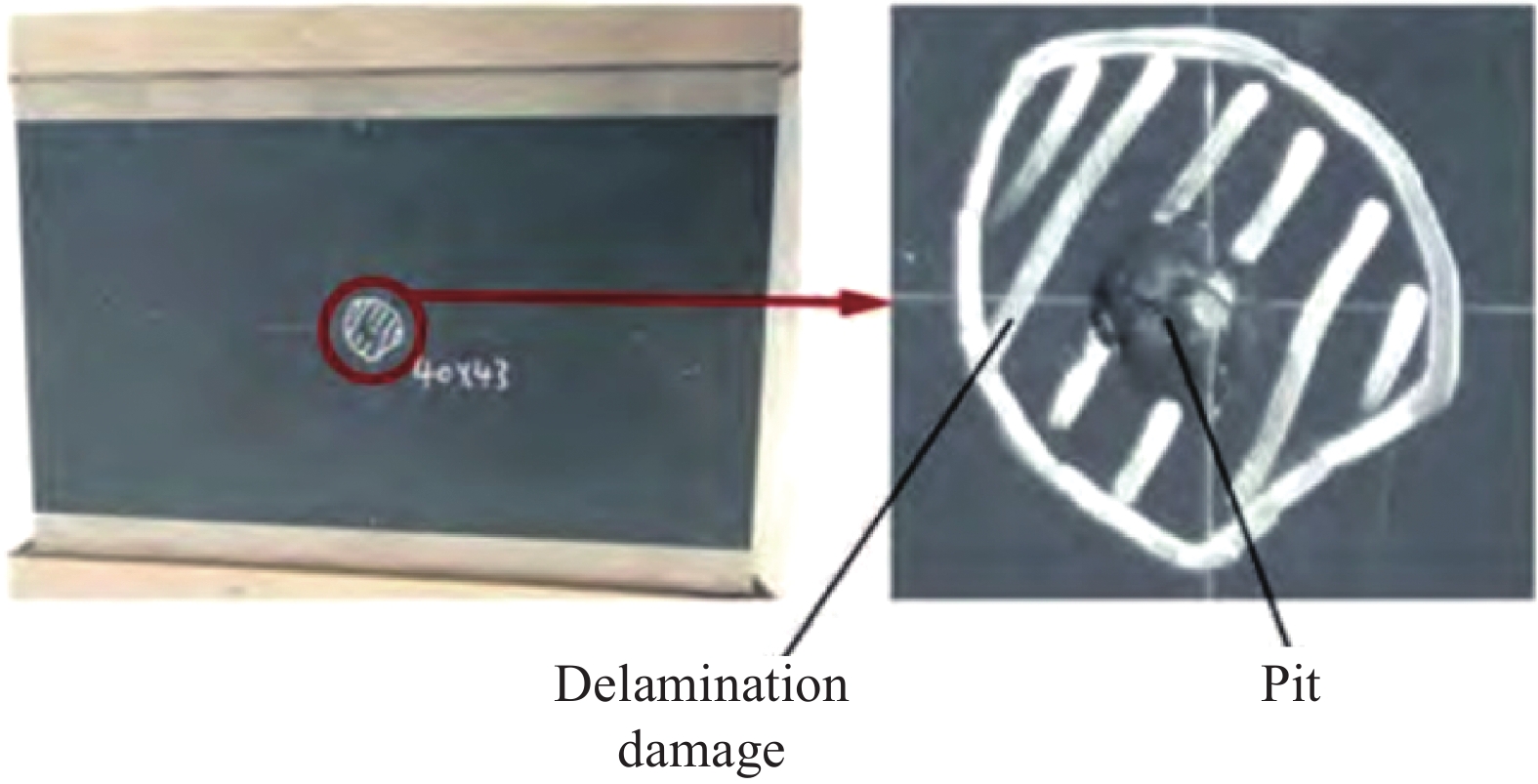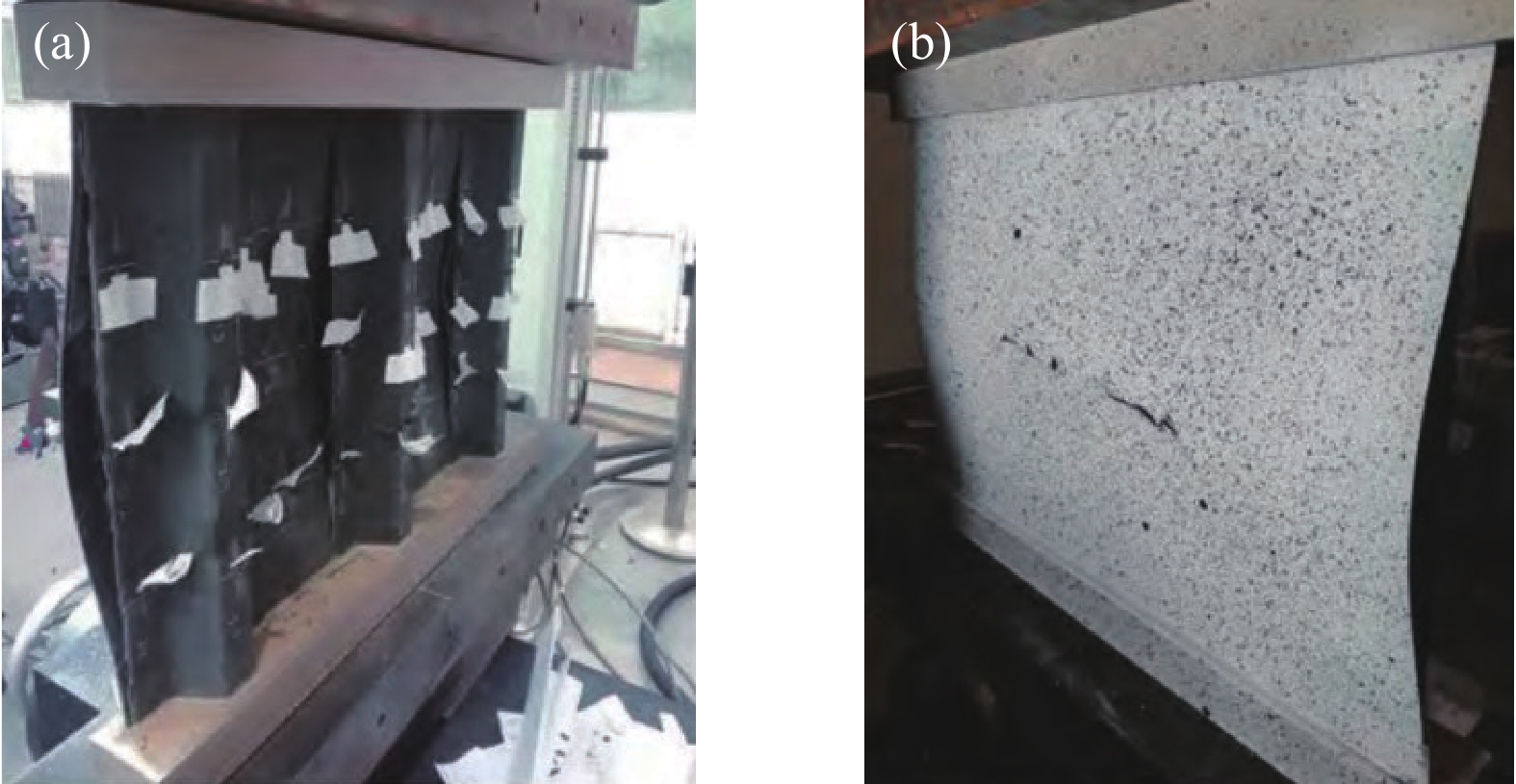Review on buckling and post-buckling of stiffened composite panels
-
摘要:
复合材料加筋板因其卓越的轻质、高强度和高刚度特性,在航空航天领域的飞机承力构件中得到了广泛应用。随着对材料性能要求的不断提升,深入理解这类结构的屈曲与后屈曲行为变得尤为重要。本文综述了国内外复合材料加筋板屈曲及后屈曲性能的研究进展,系统归纳了理论方法、有限元仿真技术及实验研究方法。研究表明:加筋板的几何参数(如加筋高度和间距)及层合板的铺层顺序显著影响其屈曲性能;同时,考虑材料非线性和几何非线性对准确预测后屈曲行为至关重要。此外,本文探讨了预测复合材料加筋板屈曲和后屈曲失效模式及载荷的关键技术难点。通过分析现有研究的局限性,本文指出了未来可能的研究方向,为复合材料加筋板的屈曲与后屈曲研究及其工程应用提供了理论基础和实践指导。
Abstract:Composite stiffened panels are widely used in aircraft load-bearing components in the aerospace field due to their excellent lightweight, high strength and high stiffness properties. With the continuous improvement of material performance requirements, it is particularly important to have a deep understanding of the buckling and post-buckling behavior of such structures. This article reviews the research progress on buckling and post-buckling properties of composite stiffened panels, and systematically summarizes theoretical approach, finite element simulation technology and experimental research methods. Studies have shown that the geometric parameters (such as height and spacing of stiffeners) and lay-up sequence of stiffened panels significantly affect the buckling performance. At the same time, considering material nonlinearity and geometric nonlinearity is crucial to accurately predict post-buckling behavior. In addition, this article explores the key technical difficulties in predicting buckling and post-buckling failure modes and loads of composite stiffened panels. By analyzing the limitations of existing researches, this article points out possible future research directions, providing a theoretical basis and practical guidance for buckling and post-buckling research on composite stiffened panels and their engineering applications.
-
聚对苯二甲酸乙二醇酯(PET)是全球用量最大的高分子材料之一,其纤维制品俗称涤纶,是全球第一大化纤品种[1]。但PET属于易燃材料,且其燃烧时还伴有严重的熔滴现象,极易导致火灾蔓延和二次伤害,这为PET的应用带来了极大的安全隐患,也使其在军事、工业等诸多领域的应用受到限制[2]。目前PET阻燃改性的主流方法是引入含磷阻燃剂,但含磷聚酯的阻燃性主要是通过熔体滴落带走燃烧区域的热量和火焰来实现的[3-4],未能解决PET的熔滴问题。因此,同时赋予PET阻燃和抗熔滴特性是目前PET阻燃改性面临的一大难点。
相关研究表明,提高聚合物高温下的熔体黏度和炭化能力是实现阻燃和抗滴落的关键[5-6]。但由于PET分子链的线性结构,其在高温下具有较低的熔融黏度,这一特性在赋予其可纺性的同时,也导致其在燃烧过程中表现出严重的熔滴行为,并难以形成连续的炭层[7]。在PET中引入可交联结构单元是提高熔体黏度的一个有效途径[6, 8]。例如,Wu等[9]合成了一种芳香族席夫碱5-(亚苄基-氨基)-间苯二甲酸二甲酯,并将其用作PET的共聚单体;研究结果显示,芳族席夫碱可以在PET的熔融温度和分解温度之间形成稳定的交联网络,并在燃烧中进一步转变为致密的炭层,因而使得PET共聚酯显示出优异的自熄和抗滴落行为。但尽管上述共聚酯表现出较为理想的阻燃性和抗滴落性能,问题仍然存在。除了工艺复杂、成本高、工业化困难之外,共聚法往往会破坏分子链的规整性,从而损害PET的力学性能和可纺性。
近年来,碳基阻燃剂作为一种新型阻燃剂表现出巨大的发展潜力。研究表明,碳纳米管[10]、富勒烯[11]、纳米炭黑[12]、石墨烯[13]、碳微球[14]等碳基阻燃剂在改善聚合物的成炭质量、降低热释放速率、提高热稳定性等方面表现突出。与传统阻燃剂相比,往往少量碳基阻燃剂的引入即可显著提高聚合物的阻燃性,除此之外,引入碳基阻燃剂还能不同程度地改善聚合物的力学、热学以及电学等性能[15]。其中,碳纳米球(Carbon nanospheres,CNSs)具有无卤环保、粒径小、热稳定性高等优势,能满足PET高温加工和熔融纺丝的理论要求,但迄今为止,将碳基阻燃剂应用于PET的研究较少。
基于此,本文以CNSs为基体,在其表面接枝芳香席夫碱4-苯亚甲基氨基苯酚(4-phenyl-methyleneamino-phenol,BA)制备了一种新型碳纳米球基复合阻燃剂(CNSs-BA),旨在将CNSs和BA的优势有机结合,使阻燃剂同时具备“智能自交联”特性,从而在燃烧时在PET基体中形成三维交联网络,进而改善熔滴。重点研究了CNSs-BA/PET复合材料的阻燃性及其阻燃机制。
1. 实验材料及方法
1.1 原材料
蒸馏水,使用XY-ZL-20型蒸馏水器自制。碳纳米球(CNSs),纯度99.99%,宁波金雷纳米材料科技有限公司;30%过氧化氢,优级纯,上海沃凯生物技术有限公司;硫酸,分析纯,华东医药股份有限公司;二氯甲烷(DCM),分析纯,华东医药股份有限公司;4-苯亚甲基氨基苯酚(BA),纯度98%,东京化成工业株式会社;4-二甲氨基吡啶(DMAP),纯度99%,阿拉丁试剂(上海)有限公司;无水乙醇,分析纯,嘉兴市甬宏化工有限公司;PET切片,半消光型SD500,中国石化仪征化纤股份有限公司。
1.2 CNSs-BA阻燃剂的制备
首先采用酸化法[16]制备羧基化碳纳米球(CNSs-COOH);在DCM中加入适量氯化钙,常温振荡12 h以去除其中的水分,使用时用吸管吸取上层液体用。在三口烧瓶中加入一定量的无水DCM (50~100 mL)作为反应溶剂。搅拌状态下加入3 g CNSs-COOH,再加入1 g BA和DMAP (作为碱性催化剂,DMAP的用量为BA用量的1/10),升温至30℃,之后在搅拌状态下反应2 h,反应完成后抽滤除去液体。将反应所得固体依次用乙醇和蒸馏水洗涤,100℃下干燥6 h后研磨均匀,即得CNSs-BA阻燃剂,CNSs-BA的制备示意图见图1。
1.3 CNSs-BA/PET复合材料的制备
首先将纯PET切片和制备的CNSs-BA阻燃剂分别在120℃下真空干燥12 h后冷却至室温备用,然后分别按CNSs-BA占PET的质量分数为0.5wt%、1.0wt%、2.0wt%、3.0wt% 的比例将CNSs-BA与PET切片混合均匀后喂入BP-8188型转矩流变仪(东莞市宝品精密仪器有限公司)中,转矩流变仪各区的温度依次为150、255、273、275℃,转速为35~60 r/min,熔体依次经过熔融共混、挤出、切粒工序得到CNSs-BA/PET复合材料。
1.4 测试与表征
CNSs-BA阻燃剂的测试与表征:用JSM-6510LA型场发射扫描电镜(SEM,日本电子株式会社)和EM420型透射电子显微镜(赛默飞世尔科技)观察阻燃剂的微观形貌,加速电压3 kV 和20 kV。用Perkin Elmer Frontier型傅里叶变换红外光谱仪(FTIR),溴化钾压片法分析测定阻燃剂表面性质和化学结构,光谱记录范围
4000 ~400 cm−1。用Perkin Elmer TG4000型热重分析仪(TG),在N2气氛下测试阻燃剂的热稳定性,气体流速20 mL/min,程序设定为:30℃恒温1 min后以20℃/min的升温速率升温至800℃。CNSs-BA/PET复合材料的测试与表征:用TM606 数显氧指数测试仪(青岛睿新杰仪器有限公司),按照GB/T 2406.2—2009[17]测试PET及其阻燃复合材料的极限氧指数(LOI),样条尺寸为120 mm×6.5 mm×3 mm。用CZF-5水平垂直燃烧仪(沧州冀路试验仪器有限公司),按照 GB/T 2408—2008[18]判定PET及其阻燃复合材料的UL-94垂直燃烧等级,样品尺寸为130 mm×13 mm×3 mm。用C-1087型锥形量热仪(英国FTT),按照ISO 5660-1: 2015[19]测试PET及其阻燃复合材料的燃烧热释放(HRR)等参数,样品尺寸:100 mm×100 mm×3 mm,辐射照度50 kW/m2。用Perkin Elmer TG4000型热重分析仪(TG),在N2气氛下测试PET及其阻燃复合材料(阻燃剂含量2wt%)的热稳定性,气体流速20 mL/min,程序设定为:30℃恒温1 min后以20℃/min的升温速率升温至800℃。用Netzsch STA449F5型同步热分析仪(TG-DSC)研究PET及其阻燃复合材料(阻燃剂含量2.0wt%)的交联行为,氩气做保护气,空气气氛,气体流速20 mL/min,升温速率为10℃/min,测试温度范围为30~800℃。用气相Agilent 6980N色谱仪,Agilent 5975质谱仪,采用HP-5MS色谱柱对PET及其阻燃复合材料(阻燃剂含量2.0wt%)进行裂解-气相色谱-质谱联用(Py-GC-MS)测试。裂解条件:裂解温度750℃,时间20 s,升温速率200℃/s。色谱条件:柱温在50℃保持5 min,然后以10℃/min升温至260℃,在260℃保持10 min;进样温度220℃,传输温度280℃,He做载气,流量1.0 mL/min;裂解产物经色谱柱分离后进入质谱仪,电子能量为70 eV。
残炭的测试与表征:采用SEM观察PET及其阻燃复合材料(阻燃剂含量2.0wt%)燃烧后残炭的形貌,并用其配套的EDS能谱设备对残炭进行元素分析。采用TG在N2气氛下测试残炭的热稳定性,气体流速20 mL/min,程序设定为:30℃恒温1 min后以20℃/min的升温速率升温至800℃。
2. 结果与讨论
2.1 CNSs-BA的形貌结构和热稳定性
图2为原CNSs (图2(a))和CNSs-BA (图2(b))的SEM、TEM和EDS能谱图。可知:CNSs和CNSs-BA二者均呈规则的球形颗粒状。不同的是,原始CNSs表面光滑,平均粒径约45 nm。而经BA接枝后,CNSs-BA的表面变得粗糙,平均粒径增大到50 nm左右,由EDS谱图可知:纯CNSs中的主要成分为C元素,与CNSs相比,CNSs-BA的表面增加了N元素,源自其表面接枝的BA中的氨基。
图3是CNSs和CNSs-BA的红外图谱。对比CNSs和CNSs-BA的FTIR曲线可知,在CNSs-BA的红外曲线中,
3330 cm−1和3380 cm−1处对应N—H的伸缩振动峰,2925 cm−1和2850 cm−1处为亚甲基的伸缩振动峰,1450 cm−1处的特征峰是芳环骨架的伸缩振动峰,1269 cm−1处的特征峰是酯基C(O)—O的伸缩振动峰,1045 cm−1处的特征峰是芳环上1, 4位取代的振动峰,以上特征峰源自CMSs表面接枝的BA。图4为CNSs和CNSs-BA的TG曲线。可知:纯CNSs的初始分解温度(Tonset,定义为热失重5wt%时的温度)大于800℃,经BA接枝后Tonset降低到483.1℃,该温度远高于PET的加工温度和热分解温度。纯CNSs和CNSs-BA的最高热分解速率的温度(Tmax)分别为158.4℃和177.4℃,说明CNSs经BA接枝后热分解速率减慢。CNSs在30~800℃之间表现出3个较为明显的失重阶段,338.7℃之前对应CNSs中的少量结晶水和无定形碳的分解,338.7~544.1℃之间对应CNSs主体的热分解,544.1℃之后对应热分解产物的再分解。而CNSs-BA可划分为4个失重阶段:前两个阶段分别对应结晶水、无定形碳、小分子产物的分解以及CNSs-BA主体的分解,值得注意的是,544.1℃之后,CNSs-BA出现一个较为明显的失重峰,而CNSs的DTG曲线上并无该峰,该失重峰的出现证明CNSs表面接枝的BA在第二阶段(PET的熔融温度和分解温度之间)形成了一个较为稳定的交联网络结构,这将十分有助于燃烧时保护炭层的形成。
2.2 复合材料的阻燃性能
表1是CNSs-BA/PET复合材料的LOI和UL-94垂直燃烧测试结果。可知,与CNSs/PET相比,CNSs-BA/PET复合材料的LOI进一步提高,二者LOI规律变化一致,即随着阻燃剂含量的增大,LOI先提高后降低,当CNSs-BA含量为2.0wt%时,CNSs-BA/PET的LOI指数达到最大值28.1%,此时与纯PET相比,CNSs-BA/PET的LOI提高了33.8%。UL-94垂直燃烧测试结果表明,CNSs-BA/PET复合材料的抗熔滴性能较CNSs/PET也有明显提高,两次施加火焰后的余焰时间明显缩短,当CNSs-BA的添加量超过2.0wt%时,CNSs-BA/PET复合材料的阻燃等级可达到V-0级。
表 1 复合材料的极限氧指数(LOI)和UL-94垂直燃烧测试结果Table 1. Limiting oxygen index (LOI) and UL-94 vertical burning test results of compositesSample Flame retardant content/wt% LOI/% UL-94 vertical combustion test results t1/s t2/s t3/s Ignite cotton? Rate PET — 21.0 Burn out — — Yes NR CNSs/PET 0.5 23.2 2.6 2.5 0 Yes V-2 1.0 25.0 2.4 2.4 0 Yes V-2 2.0 26.2 2.4 2.8 0 Yes V-2 3.0 24.6 3.1 2.2 0 Yes V-2 CNSs-BA/PET 0.5 24.0 1.5 2.3 0 Yes V-2 1.0 26.9 1.2 2.1 0 Yes V-2 2.0 28.1 0.5 2.2 0 No V-0 3.0 27.5 0.6 1.9 0 No V-0 Notes: PET—Polyethylene terephthalate; t1—Afterglow time after the first application of flame; t2—Afterglow time after the second application of flame; t2—Afterglow time; NR—No rate. 锥形量热仪测试结果见图5和表2。热释放速率(HRR)是表征材料火灾危险性的主要依据。结合图5和表2可知,纯PET被点燃后热释放速率急剧增大,其峰值热释放速率(pk-HRR)为810.45 kW/m2,总热释放(THR)为150.27 MJ/m2。与之相比,CNSs-BA/PET的THR与之接近,但HRR曲线却明显变平缓。值得注意的是,CNSs-BA/PET的HRR曲线表现出两个明显的热释放阶段,即在热释放速率达到峰值之后又出现了一个较为平缓的放热平台(当CNSs-BA含量为0.5wt%时表现为放热峰),这意味着CNSs-BA/PET在燃烧过程中的热释放受到抑制,这是由燃烧时炭层的形成或可燃气体减少导致的[20]。此外,表2表明,与CNSs/PET相比,CNSs-BA/PET复合材料的pk-HRR进一步降低。当CNSs-BA 含量为2.0wt%时,CNSs-BA/PET的pk-HRR最小,为435 kW/m2,该值与相同阻燃剂含量的CNSs/PET相比降低了7.6%,较纯PET降低了46.3%,说明CNSs经BA接枝后对PET的燃烧抑制作用进一步增强,阻燃效果进一步提高。
表 2 复合材料的锥形量热仪测试数据Table 2. Data of cone calorimeter test of compositesSample FR content/wt% TTI/s Time to pk-HRR/s pk-HRR/(kW·m−2) THR/(MJ·m−2) PET 0 47 104 810.45 150.27 CNSs/PET 0.5 44 34 528.96 151.64 1 34 34 503.44 148.03 2 40 41 470.72 146.06 3 30 29 501.49 143.19 CNSs-BA/PET 0.5 35 39 485.54 146.54 1 31 55 469.98 156.04 2 34 39 435.00 146.54 3 30 39 466.05 156.69 Notes: TTI—Time to ignition; pk-HRR—Peak heat release rate; FR—Flame retardant. 2.3 复合材料的阻燃机制研究
2.3.1 阻燃复合材料的热重分析
为了研究阻燃剂的引入对PET的热降解行为的影响,对PET、CNSs/PET和CNSs-BA/PET在氮气气氛下的TG-DTG曲线作了对比分析,并计算了CNSs/PET和CNSs-BA/PET在500℃时残炭量的理论值,如图6和表3所示。由图6可知:在氮气气氛下,PET、CNSs/PET和CNSs-BA/PET三者的TG曲线和DTG曲线基本重合,说明加入少量(2.0wt%)的CNSs和CNSs-BA均不会对PET的无氧降解行为造成明显影响。由表4可知,PET、CNSs/PET和CNSs-BA/PET三者的Tonset和Tmax均较为接近,但三者在高温(500℃)下的残余质量有所不同。经计算发现CNSs/PET和CNSs-BA/PET二者在高温下残炭量的实际值(CR500℃,exp)均大于理论值(CR500℃,cal),这说明阻燃剂CNSs和CNSs-BA对PET均有促进成炭作用。其中,CNSs-BA/PET在500℃下残炭量的实际值与理论值的差值(∆CR500℃)大于CNSs/PET,这说明CNSs经BA接枝后对PET的促进成炭作用加强。聚合物在高温下形成的残炭越多,燃烧时发生热分解的部分就越少[21],这便是阻燃复合材料热释放速率降低的主要原因之一。
表 3 CNSs、CNSs-BA以及PET、CNSs/PET、CNSs-BA/PET在氮气气氛下的TG-DTG数据Table 3. TG-DTG data of CNSs, CNSs-BA, PET, CNSs/PET and CNSs-BA/PET under nitrogen atmosphereSample Tonset/℃ Tmax/℃ CR500℃/% ∆CR500℃/%c exp.a/cal.b CNSs >800 — 96.88/— — CNSs-BA 476.4 — 94.92/— — PET 379.1 419.1 10.09/— — CNSs/PET 380.1 421.4 13.97/11.52 2.45 CNSs-BA/PET 382.0 420.1 15.68/11.79 3.89 Notes: a CR500℃,exp. is the experimental value of char residue; b CR500℃,cal. is the calculated value of char residue; c ∆CR500℃=CR500℃,exp.−CR500℃,cal.. 表 4 PET、CNSs/PET和CNSs-BA/PET在空气气氛下的TG-DTG数据Table 4. TG-DTG data of PET, CNSs/PET and CNSs-BA/PET under air atmosphereSample Tonset/℃ Tmax-1/℃ Tmax-2/℃ PET 397.3 433.4 585.1 CNSs/PET 359.1 438.4 567.5 CNSs-BA/PET 391.0 439.7 563.3 Notes: Tmax-1—Maximum weightlessness temperature in the first stage; Tmax-2—Maximum weightlessness temperature of the second stage. 2.3.2 残炭分析
对纯PET、CNSs/PET和CNSs-BA/PET锥形量热仪测试后的残炭做了SEM和TG分析以进一步研究阻燃机制。
炭层的形貌结构和稳定性对于提高聚合物的阻燃性能至关重要,有效的炭层可通过阻止聚合物内部与可燃气体、氧气的接触来实现阻燃目的。图7为纯PET、CNSs/PET和CNSs-BA/PET炭层的SEM图像。可见,纯PET燃烧生成的炭层稀薄空且松散,表面存在大量气体逸出形成的气孔,显然这种形貌的炭层无法形成有效的屏障作用。与纯PET相比,CNSs/PET的炭层的致密性明显提高,气孔明显变小,意味着炭层有效性的提高。值得注意的是,与CNSs/PET相比,CNSs-BA/PET炭层的致密性和连续性得到了进一步改善,表面气孔也明显变少和变小,另外还存在大量鼓起的未破裂气泡,这种形貌的炭层在燃烧时一方面能有效地阻隔热量的传递,另一方面还能有效地阻隔PET燃烧降解生成的气态可燃物的逸出,起到隔热和隔氧的作用[22-23]。除此之外,CNSs-BA受热分解生成的CO2、氨气、氮气等难燃性气体能够稀释燃烧区域可燃气体的浓度,抑制燃烧的发展,这便是CNSs-BA/PET阻燃性提高的重要原因。
图8是PET、CNSs/PET和CNSs-BA/PET炭层的TG曲线。可知,纯PET炭层的Tonset较低,为215.08℃,其中100℃前失重为4.36wt%,这主要是由于纯PET的炭层结构松散、孔洞较多,容易吸收水分和储存小分子气体所致,其800℃时的残余质量为87.2wt%。在整个升温过程中,纯PET的炭层表现出3个失重阶段,第一个失重阶段发生在100℃之前,主要对应炭层中贮存的水分以及气态小分子的降解;第二个失重阶段发生在100~530℃之间,对应炭层主体部分的降解;第三个失重阶段发生在530℃之后,对应炭层热降解产物的再降解。与之相比,CNSs/PET炭层的Tonset提高到615.37℃,800℃时的残余质量提高到89.1wt%,这主要是由于CNSs/PET的炭层的致密性提高所致,其TG曲线基本保持了纯PET炭层的3个失重阶段。与PET和CNSs/PET的炭层相比,CNSs-BA/PET炭层的Tonset提高到800℃以上,意味着炭层在燃烧时能耐受更高的温度,从而更持久有效地起到凝聚相阻燃作用。值得注意的是,其炭层在热分解过程中只有一个较为明显的失重平台,并未像PET和的CNSs/PET的炭层一样经历3个失重阶段,说明阻燃剂CNSs-BA能使PET燃烧生成结构稳定的炭层,该炭层在燃烧过程中能耐受较高的火焰温度,从而对内部的基体起到持久有效的保护作用。
2.3.3 交联行为分析
聚合物的交联直接影响其热性能、流变性、成炭性、熔滴和自熄行为,并有助于聚合物的芳香化或炭化[24]。图9是PET、CNSs/PET和CNSs-BA/PET在热氧降解过程中的TG-DSC曲线,相关数据见表4。由图9可以看出,PET、CNSs/PET和CNSs-BA/PET在空气中均有两个失重阶段,说明PET及其复合材料发生的是两步降解反应[25]。第一个失重阶段是PET的主要失重阶段,发生在360~470℃之间。第二个失重阶段发生在470~590℃之间,该阶段对应第一个降解阶段生成的降解产物的进一步降解。值得注意的是,纯PET的Tonset为397.3℃,而PET的燃点通常在420℃左右,这说明PET在燃烧之前,首先会发生一定程度的降解并生成一些可燃性的气体或挥发性产物,以此来维持燃烧的进行。与纯PET相比,在第一个失重阶段,CNSs/PET和CNSs-BA/PET的热失重曲线稍向低温方向移动,但二者在第一个降解阶段结束时的剩余质量却大于PET,且该阶段的最大失重率所对应温度(Tmax-1)大于PET,说明阻燃剂的存在使PET的主体降解提前,但在该阶段却重组生成了热稳定性较高的物质。DSC曲线表明,CNSs-BA/PET在熔融峰和分解峰之间出现了明显的放热峰,该峰是PET的交联峰[26],而在PET和CNSs/PET的DSC曲线上交联峰却不明显,这说明CNSs经BA接枝改性后促进了PET的交联,这是由于阻燃剂表面接枝的芳香族席夫碱(BA)可以在PET的熔融温度和分解温度之间形成稳定的交联网络。
2.3.4 高温裂解产物分析
裂解-气相色谱-质谱联用(Py-GC-MS)是目前研究聚合物高温裂解产物的常用方法[27]。为了研究阻燃剂的引入对PET的热裂解行为及其高温裂解产物的影响,对PET、CNSs/PET和CNSs-BA/PET做了Py-GC-MS分析,三者的高温裂解产物对比见表5。可知,与纯PET的裂解产物相比,CNSs/PET和CNSs-BA/PET的裂解产物中都包含更多的杂环、稠环、共轭芳环类化合物,这些裂解产物具有较高的热稳定性,是难燃性的保护炭层形成的物质基础[28]。而CNSs-BA/PET的裂解产物中出现了诸如二甲基胺、偶氮苯等含氮产物,这是由于阻燃剂CNSs-BA表面接枝的苯亚甲基氨基苯酚所致。另外,与PET和CNSs/PET相比,CNSs-BA/PET的裂解产物中菲、萘、苊、芴等稠环芳烃类以及联苯类产物明显增多,佐证了CNSs-BA促进了PET降解过程中的交联,该交联一方面通过增大熔体黏度改善了熔滴现象,另一方面提高了炭层的致密性和热稳定性,这就是CNSs-BA/PET阻燃性和抗熔滴性提高的主要原因。
表 5 PET、CNSs/PET和CNSs-BA/PET裂解产物Table 5. Pyrolysis products of PET, CNSs/PET and CNSs-BA/PETPyrolysis products which found only in PET Tetrahydropyran; 2,2-dimethylpropanal; 4,8,12-trimethyl-tridecanoic acid methyl ester; 2,2-dimethoxybutane; 2-methyl-1,5-hexadien-3-yne; 1,6-heptadiyne; p-xylene; Decane; Methyl benzoate; Dodecylethyl ketone; 1-(3-methylphenyl)benzyl(2-methyl-1-methylenepropylidene); 4-methylphenyl-1-pentyn-3-ol phenol; Dimethyl 1,3-benzenedicarboxylate; Vinylmethyl terephthalate; Diphenylacetylene; Biphenyl-4-ylacetophenone; 1-(5,5-dimethyl-1,3-dioxocyclohexan-2-ylidene)-2-(N-ethylbenzothiazol-2-ylidene)-ethanes; Phthalic acid 4-formylphenyl ester; o-tertiaryl tricyclic [8.2.2.2(4,7)]hexadeca-2,4,6,8,10,12,13,15-octene; 4-(diethylaminomethyl)-2,5-dimethylphenol Pyrolysis products which found only in CNSs/PET Phenol; 1,2-dihydro-indene; 1-(4-methylphenyl)-ethanone; Stilbene; 1H-cyclopropyl[l]phenanthrene; Dihydro-p-terphenyl; 1-naphthol; Fluorene-9-methanol; 2-ethyl-1,1'-biphenyl; 1,1-diphenylethene; 4-(2-benzoyl-5-phenyl-3-thienyl)-1,2-dihydrophenanthrene; 2-phenylnaphthalenyl benzoate; 1,1-dihydro-2-phenylnaphthalenyl benzoate; 3-chlorobenzylnonyl; 1-(2,5-dimethylphenyl)ethanone; 1-(2,5-dimethylphenethyl) ethanone; Dimethyl-1H-indene; Diethylmalonic acid; 3-chlorobenzylnonyl ester Pyrolysis products which found only in CNSs-BA/PET 1,5-hexadiyne; Dimethylamine; Nitrous oxide; 1,1'-(1,4-phenylene)bis-acetophenone; 2-methylindene; Azobenzene; Benzene; (1-methyl-2-cyclopropen-1-yl)-2-methylindene; Stilbene; Ethylketone; 1-(3,4-dimethylphenyl); 1-(4-methylphenyl); 1-ethenyl-4-methylbenzene; Dibenzofuran; 2-naphthol; 4-hydroxy-1,2,3,4-tetrahydrophenanthrene; 9,10-dihydrophenanthrene; Benzopropiophenone; Fluorene; 4-vinylbiphenyl; 1,2,3,4-tetrahydrofil; 9,10-dihydrofil; 4-vinylbiphenyl; 1,4-vinylbiphenyl; Phenylacetone; 1,3,5-cycloheptatriene; 2-phenylnaphthalene; 1-acrylbenzene; 2-methylnaphthalene; 4-(2-benzoyl-5-phenyl-3-thienyl)-methylbenzoic acid; 1,3-dimethyl-1H-indene; Tricyclohexen-8-ol; Hexaethylcyclohexane; 9-phenyl-9-fluorenol; Ethylene oxide; Methoxyphenyltricyclohexadecen-5-ylmethanol; 4-benzylbiphenyl; Tritylbenzene; 9-phenylanthracene; 3-(1-phenylethoxy)-3H-isobenzofuran-1-one; 4-phenyl-3,4-dihydroisoquinoline; Oxetane; 2-phenyl; 3-phenylethynyl; Tetraphenyl; 1-[4-(2-phenylethenyl)phenyl]-ethanone; Acenaphthene; 1,2,3,5-tetraisopropyl-cyclohexane; 6,9-dimethoxy-phenazine-1-carboxylic acid; [1,1'-biphenyl]-4-yl-phenylmethanone; 1,1':4',1''-3'-methyltriphenylene Pyrolysis products which found both in PET and CNSs/PET Acetophenone; Benzoic acid; Biphenyl; 2-methyl-1,1'-biphenyl; 1,1'-(1,4-phenylene)bisacetophenone; p-terphenyl Pyrolysis products which found both in PET and CNSs-BA/PET Styrene; Acetophenone; Benzoic acid; Biphenyl; 2-ethyl-1,1'-biphenyl; Benzophenone; 9H-fluoren-9-one; p-terphenyl Pyrolysis products which found both in CNSs/PET and CNSs-BA/PET Benzene; Biphenyl; Acetophenone; Naphthalene; Toluene; Phenanthrene; Indene; 6,6-diphenylfulvene; p-terphenyl; Methylstyrene; Biphenylacetophenone; 4-ethylbiphenyl; Diphenylmethane Pyrolysis products found in PET, CNS/PET and CNSs-BA/PET Acetophenone; Benzoic acid; Biphenyl; p-terphenyl 2.4 复合材料的力学性能
图10为PET阻燃复合材料的抗拉强度和断裂伸长率图。可知,随着阻燃剂含量的增加,CNSs/PET和CNSs-BA/PET复合材料的抗拉强度和断裂伸长率均呈下降趋势。尤其是当阻燃剂含量超过2.0wt%时,PET复合材料的抗拉强度和断裂伸长率大幅度下降。这是由于高含量的阻燃剂在PET基体中形成了较大的团聚体,破坏了基体的连续性,阻碍了应力的传递所致,后续研究中应重点关注材料力学性能的改善。
3. 结 论
(1)为同时改善聚对苯二甲酸乙二醇酯(PET)的阻燃性和抗熔滴性,在碳纳米球表面接枝4-苯亚甲基氨基苯酚制备了一种新型碳基复合阻燃剂(CNSs-BA)。CNSs-BA为粒径约50 nm的球形颗粒,热稳定性良好。
(2) CNSs-BA的引入可显著提高PET的阻燃性和抗熔滴性。当CNSs-BA添加量为2.0wt%时,CNSs-BA/PET复合材料的极限氧指数(LOI)从PET的21.0%提高至28.1%,阻燃等级达到V-0级,热释放速率峰值降低了46.3%。
(3) CNSs-BA/PET表现出典型的凝聚相阻燃机制。CNSs-BA的引入能促进PET成炭,CNSs-BA/PET的高温残炭量(CR500℃)比PET提高了55.4%,且成炭量的实际值大于理论值。与纯PET的炭层相比,CNSs-BA/PET燃烧生成的炭层的致密性、连续性以及热稳定性都显著提高。这是由于CNSs-BA的引入促进了PET的高温交联,使其高温降解生成了更多的难燃性焦炭物质。
(4)本文为碳基阻燃剂的发展提供了重要理论补充,对开发无卤、阻燃、抗熔滴的PET材料具有一定的指导意义。
-
表 1 Camanho和Matthews的材料性能折减模型[29]
Table 1 Material property reduction model of Camanho and Matthews[29]
Failure mode Degradation coefficient Fiber tensile failure Ed11=0.07E11 Fiber compression failure Ed11=0.14E11 Matrix tensile/shear failure Ed22=0.2E22
Gd12=0.2G12, Gd23=0.2G23Matrix compression/shear failure Ed22=0.4E22
Gd12=0.4G12, Gd23=0.4G23Notes: E11 and E22 are the elastic moduli in the fiber and matrix directions; G12 and G23 are the shear moduli; d stands for degradation. Failure mode Degradation coefficient Fiber failure Ed11=0, Ed22=0, Gd12=0 Matrix failure Ed22=0, νd21=0 Fiber-matrix shear failure Gd12=0, νd12=0, νd21=0 Notes: Ed11 and Ed22 are the elastic moduli in the fiber and matrix directions after degradation; Gd12 is the shear moduli after degradation; νd12 and νd21 are poisson’s ratios after degradation. -
[1] CHAGRAOUI H, LAZGHAB T, SOULA M. Buckling optimization and post-buckling analysis of omega sub-stiffened composite panels using different cohesive interface properties[J]. Thin-Walled Structures, 2023, 189: 110944. DOI: 10.1016/j.tws.2023.110944
[2] WANG Y, WANG F, JIA S, et al. Experimental and numerical studies on the stability behavior of composite panels stiffened by tilting hat-stringers[J]. Composite Structures, 2017, 174: 187-195. DOI: 10.1016/j.compstruct.2017.04.039
[3] ABRAMOVICH H, WELLER T. Buckling and postbuckling behavior of laminated composite stringer stiffened curved panels under axial compression: Experiments and design guidelines[J]. Journal of Mechanics of Materials and Structures, 2009, 4(7): 1187-1207.
[4] 王海燕, 段世慧, 孙侠生. 复合材料加筋板后屈曲设计技术欧盟研究综述[J]. 航空工程进展, 2015, 6(2): 139-148. DOI: 10.3969/j.issn.1674-8190.2015.02.002 WANG Haiyan, DUAN Shihui, SUN Xiasheng. Review on the EU research projects of design and analysis of stiffened composite panels including post-buckling[J]. Advances in Aeronautical Science and Engineering, 2015, 6(2): 139-148(in Chinese). DOI: 10.3969/j.issn.1674-8190.2015.02.002
[5] 朱菊芬, 陈浩然, 陈绍杰, 等. 复合材料加筋板后屈曲强度工程分析方法探讨[J]. 航空学报, 1991(12): 639-642. DOI: 10.3321/j.issn:1000-6893.1991.12.019 ZHU Jufen, CHEN Haoran, CHEN Shaojie, et al. Engineering method research of post-buckling[J]. Acta Aeronautica et Astronautica Sinica, 1991(12): 639-642(in Chinese). DOI: 10.3321/j.issn:1000-6893.1991.12.019
[6] 张雅倩, 刘轶轩, 吴泳芙, 等. 反对称铺设复合材料层合板非线性后屈曲分析[J]. 应用力学学报, 2023, 40(4): 778-787. ZHANG Yaqian, LIU Yixuan, WU Yongfu, et al. Nonlinear post-buckling analysis of composite laminates with antisymmetric angle-ply[J]. Chinese Journal of Applied Mechanics, 2023, 40(4): 778-787(in Chinese).
[7] 钟博, 王新峰, 于健. 石英纤维与碳纤维混杂加筋壁板剪切后屈曲性能研究[J]. 南京航空航天大学学报, 2023, 55(6): 1111-1117. ZHONG Bo, WANG Xinfeng, YU Jian. Shear post-buckling behavior of quartz fiber and carbon fiber hybrid stiffened panels[J]. Journal of Nanjing University of Aernautics & Astrnautics, 2023, 55(6): 1111-1117(in Chinese).
[8] FENG Y, WANG W, LU S, et al. Axial compressive performances of stiffened composite panels: Experimental and numerical study[J]. Alexandria Engineering Journal, 2023, 71: 115-130. DOI: 10.1016/j.aej.2023.03.047
[9] FENG Y, MA B, CUI R, et al. Effects of hygrothermal environment on the buckling and postbuckling performances of stiffened composite panels under axial compression[J]. Composite Structures, 2020, 242: 112132. DOI: 10.1016/j.compstruct.2020.112132
[10] 邹建超. 纤维复合材料冲击后压缩/剪切的损伤机理及性能预测研究[D]. 大连: 大连理工大学, 2023. ZOU Jianchao. Study on damage mechanism and performance prediction of fiber composites under compression/shear after impact[D]. Dalian: Dalian University of Technology, 2023(in Chinese).
[11] 孙振亚. 基于人工神经网络的复合材料加筋板失效行为预测研究[D]. 大连: 大连理工大学, 2022. SUN Zhenya. Prediction of failure behavior of composite stiffened panels using artificial neural network[D]. Dalian: Dalian University of Technology, 2022(in Chinese).
[12] 王彬文, 艾森, 张国凡, 等. 考虑不确定性的复合材料加筋壁板后屈曲分析模型验证方法[J]. 航空学报, 2020, 41(8): 280-287. WANG Binwen, AI Sen, ZHANG Guofan, et al. Validation method for post-buckling analysis model of stiffened composite panel considering uncertainties[J]. Acta Aeronautica et Astronautica Sinica, 2020, 41(8): 223987(in Chinese).
[13] FENG Y, LIU S, ZHANG T, et al. Experimental and theoretical investigation on the shear performance of stiffened composite panel with I-shaped stiffeners[J]. Composite Structures, 2022, 284: 115234. DOI: 10.1016/j.compstruct.2022.115234
[14] 杨钧超, 柴亚南, 陈向明, 等. 复合材料加筋板剪切屈曲与后屈曲承载特性[J]. 科学技术与工程, 2019, 19(7): 289-293. DOI: 10.3969/j.issn.1671-1815.2019.07.048 YANG Junchao, CHAI Yanan, CHEN Xiangming, et al. Shear buckling and post-buckling behavior of composite stiffened panels[J]. Science Technology and Engineering, 2019, 19(7): 289-293(in Chinese). DOI: 10.3969/j.issn.1671-1815.2019.07.048
[15] HAYATDAVOODI A, SHANMUGAM N E. Web buckling and ultimate strength of composite plate girders subjected to shear and bending[J]. International Journal of Structural Stability and Dynamics, 2015, 1450047.
[16] HAYATDAVOODI A, NAZARI M, JAVADI PORDESARI A. Investigation on the collapse behavior of diagonal stiffened composite plate girders subjected to shear loading[J]. International Journal of Steel Structures, 2020, 20(2): 386-399. DOI: 10.1007/s13296-019-00291-7
[17] 高志刚, 冯宇, 马斌麟, 等. 航空复合材料加筋板压缩屈曲及后屈曲力学性能[J]. 航空材料学报, 2020, 40(1): 53-61. DOI: 10.11868/j.issn.1005-5053.2019.000067 GAO Zhigang, FENG Yu, MA Binlin, et al. Compressive bucking and post-bucking mechanical properties of aeronautic composite stiffened panel[J]. Journal of Aeronautical Materials, 2020, 40(1): 53-61(in Chinese). DOI: 10.11868/j.issn.1005-5053.2019.000067
[18] 王菲菲, 崔德刚, 熊强, 等. 复合材料加筋板后屈曲承载能力工程分析方法[J]. 北京航空航天大学学报, 2013, 39(4): 494-497. WANG Feifei, CUI Degang, XIONG Qiang, et al. Engineering analysis of post-buckling loading capability for composite stiffened panels[J]. Journal of Beijing University of Aeronautics and Astronautics, 2013, 39(4): 494-497(in Chinese).
[19] 高伟, 刘存, 陈顺强. 变厚度复合材料加筋板轴压试验及分析方法[J]. 航空学报, 2022, 43(11): 148-156. GAO Wei, LIU Cun, CHEN Shunqiang. Axial compression test and analysis method of composite stiffened plates with variable thickness[J]. Acta Aeronautica et Astronautica Sinica, 2022, 43(11): 148-156 (in Chinese).
[20] 王春寿, 张笑宇, 詹志新, 等. 复合材料厚板结构压缩稳定性和承载能力分析[J]. 北京航空航天大学学报, 2025, 51(1): 94-101. WANG Chunshou, ZHANG Xiaoyu, ZHAN Zhixin, et al. The analysis of compression stability and load capacity of the thick composite plate structures[J]. Journal of Beijing University of Aeronautics and Astronautics, 2025, 51(1): 94-101(in Chinese).
[21] PEVZNER P, ABRAMOVICH H, WELLER T. Calculation of the collapse load of an axially compressed laminated composite stringer-stiffened curved panel–An engineering approach[J]. Composite Structures, 2008, 83(4): 341-353. DOI: 10.1016/j.compstruct.2007.05.001
[22] 黄晓笛. 复合材料帽形加筋壁板轴压承载能力工程分析[D]. 大连: 大连理工大学, 2023. HUANG Xiaodi. Engineering analysis of axial compression load bearing capacity of composite omega stiffened panels[D]. Dalian: Dalian University of Technology, 2023(in Chinese).
[23] ZHAO W, KAPANIA R K. Buckling analysis of unitized curvilinearly stiffened composite panels[J]. Composite Structures, 2016, 135: 365-382. DOI: 10.1016/j.compstruct.2015.09.041
[24] FERREIRA F P V, TSAVDARIDIS K D, MARTINS C H, et al. Buckling and post-buckling analyses of composite cellular beams[J]. Composite Structures, 2021, 262: 113616. DOI: 10.1016/j.compstruct.2021.113616
[25] 袁坚锋. 基于显式有限元的复合材料加筋板后屈曲分析方法研究[J]. 机械设计与制造工程, 2021, 50(4): 73-76. DOI: 10.3969/j.issn.2095-509X.2021.04.016 YUAN Jianfeng. Research on post-buckling for composite stiffened panel based on explicit FEM[J]. Machine Design and Manufacturing Engineering, 2021, 50(4): 73-76(in Chinese). DOI: 10.3969/j.issn.2095-509X.2021.04.016
[26] 刘存, 张磊, 杨卫平. 舰载机壁板剪切后屈曲承载能力预测与试验验证[J]. 航空学报, 2019, 40(4): 49-57. LIU Cun, ZHANG Lei, YANG Weiping. Post-buckling study and test verification of carrier-based aircraft wing stiffened panels under shear load[J]. Acta Aeronautica et Astronautica Sinica, 2019, 40(4): 49-57(in Chinese).
[27] 张连青. 压剪组合载荷下复合材料壁板屈曲性能及后屈曲承载能力分析[D]. 哈尔滨: 哈尔滨工业大学, 2021. ZHANG Lianqing. Analysis of buckling behavior and post-buckling bearing capacity of composite panels under combined compression and shear loads[D]. Harbin: Harbin Institute of Technology, 2021(in Chinese).
[28] 林国伟, 李新祥. 复合材料加筋板后屈曲分析方法及实验验证[J]. 航空材料学报, 2021, 41(4): 149-156. DOI: 10.11868/j.issn.1005-5053.2021.000013 LIN Guowei, LI Xinxiang. Post-buckling analysis method of stiffened composite panels and test verification[J]. Journal of Aeronautical Materials, 2021, 41(4): 149-156(in Chinese). DOI: 10.11868/j.issn.1005-5053.2021.000013
[29] CAMANHO P P, MATTHEWS F L. A progressive damage model for mechanically fastened joints in composite laminates[J]. Journal of Composite Materials, 1999, 33(24): 2248-2280. DOI: 10.1177/002199839903302402
[30] CHANG F K, LESSARD L B. Damage tolerance of laminated composites containing an open hole and subjected to compressive loadings: Part I—Analysis[J]. Journal of Composite Materials, 1991, 25(1): 2-43. DOI: 10.1177/002199839102500101
[31] 崔进, 肖文莹, 李想. 船体复合材料帽型加筋板渐进破坏分析[J]. 舰船科学技术, 2021, 43(3): 20-25. DOI: 10.3404/j.issn.1672-7649.2021.02.004 CUI Jin, XIAO Wenying, LI Xiang. Progressive failure of hat-stringer-stiffened composite panel in the hull[J]. Ship Science and Technology, 2021, 43(3): 20-25(in Chinese). DOI: 10.3404/j.issn.1672-7649.2021.02.004
[32] 邹华民. 含初始分层缺陷复合材料加筋壁板承载性能分析[D]. 大连: 大连理工大学, 2018. ZOU Huamin. Bearing capacity analysis of composite stiffened panels with initial delamination defects [D]. Dalian: Dalian University of Technology, 2018(in Chinese).
[33] 邹华民, 崔向斌, 任明法, 等. 含初始脱粘缺陷复合材料加筋壁板渐进压溃过程的数值模拟[J]. 玻璃钢/复合材料, 2017(11): 12-18. ZOU Huamin, CUI Xiangbin, REN Mingfa, et al. Numerical simulation on progressive collapse process of composite stiffened panel with initial debonding defect[J]. Fiber Reinforced Plastics/Composites, 2017(11): 12-18(in Chinese).
[34] 韩庆, 宋恩鹏, 陆华, 等. 复合材料加筋结构后屈曲的自开发程序[J]. 复合材料学报, 2017, 34(7): 1443-1450. HAN Qing, SONG Enpeng, LU Hua, et al. Self-developed program for post-buckling of composite stiffened structures[J]. Acta Materiae Compositae Sinica, 2017, 34(7): 1443-1450(in Chinese).
[35] ORIFICI A C, HERSZBERG I, THOMSON R S. Review of methodologies for composite material modelling incorporating failure[J]. Composite Structures, 2008, 86(1): 194-210.
[36] 王涛. 基于筋元界面的复合材料帽型加筋板失效分析[D]. 大连: 大连理工大学, 2023. WANG Tao. Failure analysis of composite hat-stiffened panels based on interface failure behavior of stiffener element [D]. Dalian: Dalian University of Technology, 2023(in Chinese).
[37] 李乐坤, 张铁军, 支乐, 等. 湿热环境下复合材料加筋壁板压缩屈曲与后屈曲行为的有限元模拟[J]. 机械工程材料, 2023, 47(8): 93-99. DOI: 10.11973/jxgccl202308015 LI Lekun, ZHANG Tiejun, ZHI Le, et al. Finite element modelling for buckling and post-buckling behavior of composite stiffened panel during compression in hygrothermal environment[J]. Materials for Mechanical Engineering, 2023, 47(8): 93-99(in Chinese). DOI: 10.11973/jxgccl202308015
[38] JI R, ZHAO L, WANG K, et al. Effects of debonding defects on the postbuckling and failure behaviors of composite stiffened panel under uniaxial compression[J]. Composite Structures, 2021, 256: 113121. DOI: 10.1016/j.compstruct.2020.113121
[39] YE Y, ZHU W, JIANG J, et al. Computational modelling of post-buckling behavior of composite T-stiffened panels with different bonding methods[J]. Composites Part B: Engineering, 2019, 166: 247-256. DOI: 10.1016/j.compositesb.2018.11.137
[40] 胡波涛, 柴亚南, 陈向明, 等. 后屈曲复合材料加筋板筋条-蒙皮界面失效表征[J]. 机械强度, 2019, 41(6): 1473-1479. HU Botao, CHAI Yanan, CHEN Xiangming, et al. Stiffener-skin interface failure characterization of the stiffened composite panel at post-buckling stage[J]. Journal of Mechanical Strength, 2019, 41(6): 1473-1479(in Chinese).
[41] VAN DOOREN K, BISAGNI C. Design, analysis and testing of thermoplastic welded stiffened panels to investigate skin-stringer separation in post-buckling[J]. Composites Part B: Engineering, 2023, 267: 111033. DOI: 10.1016/j.compositesb.2023.111033
[42] VAN DOOREN K S, TIJS B H A H, WALESON J E A, et al. Skin-stringer separation in post-buckling of butt-joint stiffened thermoplastic composite panels[J]. Composite Structures, 2023, 304: 116294. DOI: 10.1016/j.compstruct.2022.116294
[43] BERTOLINI J, CASTANIÉ B, BARRAU J J, et al. An experimental and numerical study on omega stringer debonding[J]. Composite Structures, 2008, 86(1): 233-242.
[44] RAIMONDO A, DOESBURG S A, BISAGNI C. Numerical study of quasi-static and fatigue delamination growth in a post-buckled composite stiffened panel[J]. Composites Part B: Engineering, 2020, 182: 107589. DOI: 10.1016/j.compositesb.2019.107589
[45] 田甜, 张帆, 许健. 复合材料加筋壁板压缩试验研究与仿真分析[J]. 科技创新与应用, 2018(5): 45-46. TIAN Tian, ZHANG Fan, XU Jian. Compression test research and simulation analysis of composite stiffened panel[J]. Technology Innovation and Application, 2018(5): 45-46(in Chinese).
[46] 杜洪雨, 奚晓波, 孟力华, 等. 含分层损伤的复合材料层压板后屈曲及低周疲劳分层扩展有限元模拟研究[J]. 玻璃钢/复合材料, 2018(6): 39-43. DU Hongyu, XI Xiaobo, MENG Lihua, et al. Finite element analysis of post-buckled delamination of composite laminate with preliminary debond subjected to static and fatigue loads[J]. Fiber Reinforced Plastics/Composites, 2018(6): 39-43(in Chinese).
[47] DÁVILA C G, BISAGNI C. Fatigue life and damage tolerance of postbuckled composite stiffened structures with initial delamination[J]. Composite Structures, 2017, 161: 73-84. DOI: 10.1016/j.compstruct.2016.11.033
[48] 唐劼尧, 柏敏建. 轴压载荷下复合材料蜂窝夹芯板的稳定性研究[J]. 兵器装备工程学报, 2020, 41(9): 242-246. DOI: 10.11809/bqzbgcxb2020.09.045 TANG Jieyao, BAI Minjian. Stability evaluation on composite honeycomb sandwich panels subjected to compressive loadings[J]. Journal of Ordnance Equipment Engineering, 2020, 41(9): 242-246(in Chinese). DOI: 10.11809/bqzbgcxb2020.09.045
[49] 李晓文, 朱兆一, 李妍, 等. 船舶复合材料加筋板屈曲和后屈曲行为研究[J]. 中国造船, 2020, 61(3): 186-194. DOI: 10.3969/j.issn.1000-4882.2020.03.020 LI Xiaowen, ZHU Zhaoyi, LI Yan, et al. Research on buckling and post buckling behavior of composite stiffened panel for ships[J]. Ship Building of China, 2020, 61(3): 186-194(in Chinese). DOI: 10.3969/j.issn.1000-4882.2020.03.020
[50] KOLANU N R, RAJU G, RAMJI M. Experimental and numerical studies on the buckling and post-buckling behavior of single blade-stiffened CFRP panels[J]. Composite Structures, 2018, 196: 135-154. DOI: 10.1016/j.compstruct.2018.05.015
[51] 孙中雷, 张国凡, 李军鹏. 轴压载荷下复合材料加筋板后屈曲承载能力研究[J]. 航空计算技术, 2016, 46(3): 63-66. DOI: 10.3969/j.issn.1671-654X.2016.03.016 SUN Zhonglei, ZHANG Guofan, LI Junpeng. Study on loading capacity of composite panels under uniaxial compression[J]. Aeronautical Computing Technique, 2016, 46(3): 63-66(in Chinese). DOI: 10.3969/j.issn.1671-654X.2016.03.016
[52] 张修路, 黄文超, 方采文, 等. 飞机复合材料加筋壁板结构屈曲和后屈曲研究[J]. 计算机仿真, 2020, 37(12): 230-234, 408. DOI: 10.3969/j.issn.1006-9348.2020.12.048 ZHANG Xiulu, HUANG Wenchao, FANG Caiwen, et al. The investigation on buckling and post buckling of aircraft composite panel structure[J]. Computer Simulation, 2020, 37(12): 230-234, 408(in Chinese). DOI: 10.3969/j.issn.1006-9348.2020.12.048
[53] 林国伟, 李新祥. 复合材料壁板后屈曲分析失效准则的适用性研究[J]. 机械强度, 2020, 42(3): 565-572. LIN Guowei, LI Xinxiang. Applicability investigation of failure criterion for post-buckling analysis of stiffened composite panels[J]. Journal of Mechanical Strength, 2020, 42(3): 565-572(in Chinese).
[54] LIAN C, WANG P, ZHANG K, et al. Experimental and numerical research on the calculation methods for buckling and post-buckling of aircraft tail inclined stiffened panel under compression load[J]. Aerospace Science and Technology, 2024, 146: 108930. DOI: 10.1016/j.ast.2024.108930
[55] LIAN C, WANG P, CHEN X, et al. Experimental and numerical research on the analysis methods for buckling and post-buckling of inclined stiffened panel under shear load[J]. Thin-Walled Structures, 2024, 195: 111374. DOI: 10.1016/j.tws.2023.111374
[56] 王维阳, 李伟, 曹奇凯. 复合材料加筋板轴压后屈曲及承载有限元分析[J]. 计算机仿真, 2022, 39(5): 474-479. DOI: 10.3969/j.issn.1006-9348.2022.05.095 WANG Weiyang, LI Wei, CAO Qikai. Finite element analysis of post-buckling and bearing capability of composite stiffened plates under axial compression[J]. Computer Simulation, 2022, 39(5): 474-479(in Chinese). DOI: 10.3969/j.issn.1006-9348.2022.05.095
[57] 李小乐. 含开口复合材料层合板的剪切承载及后屈曲渐进损伤研究[D]. 哈尔滨: 哈尔滨工业大学, 2019. LI Xiaole. Bearing characteristics and post-buckling progressive failure behavior of composite laminate with cutout under shear load [D]. Harbin: Harbin Institute of Technology, 2019(in Chinese).
[58] SUN W, GUAN Z, LI Z, et al. Modelling and simulating of the compressive behavior of T-stiffened composite panels subjected to stiffener impact[J]. Composite Structures, 2018, 186: 221-232. DOI: 10.1016/j.compstruct.2017.11.079
[59] 黎汉华. 复合材料格栅加筋结构损伤对力学性能影响研究[D]. 哈尔滨: 哈尔滨工业大学, 2021. LI Hanhua. Influence of damage on mechanical properties of composite grid reinforced structure[D]. Harbin: Harbin Institute of Technology, 2021(in Chinese).
[60] 杨钧超, 王雪明, 陈向明, 等. 低速冲击损伤对复材加筋板压缩性能的影响[J]. 航空学报, 2023, 44(20): 248-263. DOI: 10.7527/S1000-6893.2023.28498 YANG Junchao, WANG Xueming, CHEN Xiangming, et al. Effect of low-velocity impact damage on compressive properties of composite stiffened panels[J]. Acta Aeronautica et Astronautica Sinica, 2023, 44(20): 248-263(in Chinese). DOI: 10.7527/S1000-6893.2023.28498
[61] 杨钧超, 陈向明, 邹鹏, 等. 复合材料层合板剪切稳定性试验及强度预测[J]. 复合材料学报, 2023, 40(3): 1707-1717. YANG Junchao, CHEN Xiangming, ZOU Peng, et al. Shear stability test and strength prediction of composite laminates[J]. Acta Materiae Compositae Sinica, 2023, 40(3): 1707-1717(in Chinese).
[62] MASOOD S N, VISHAKH R, VISWAMURTHY S R, et al. Influence of stiffener configuration on post-buckled response of composite panels with impact damages[J]. Composite Structures, 2018, 194: 433-444. DOI: 10.1016/j.compstruct.2018.04.005
[63] WU Q, HU S, TANG X, et al. Compressive buckling and post-buckling behaviors of J-type composite stiffened panel before and after impact load[J]. Composite Structures, 2023, 304: 116339. DOI: 10.1016/j.compstruct.2022.116339
[64] 胡少杰. J型复合材料加筋板压缩屈曲及后屈曲行为研究[D]. 哈尔滨: 哈尔滨工业大学, 2022. HU Shaojie. Research on compression buckling and post-buckling behavior of J-type composite stiffened plate[D]. Harbin: Harbin Institute of Technology, 2022(in Chinese).
[65] WANG X M, CAO W, DENG C H, et al. Experimental and numerical analysis for the post-buckling behavior of stiffened composite panels with impact damage[J]. Composite Structures, 2015, 133: 840-846. DOI: 10.1016/j.compstruct.2015.08.019
[66] 付新卫, 刘瑞同, 戴瑛. 夹具对复合材料加筋板剪切试验屈曲载荷的影响[J]. 力学季刊, 2011, 32(4): 563-569. FU Xinwei, LIU Ruitong, DAI Ying. Effects of support fixture on the buckling loads in shear test of stiffened composites plate[J]. Chinese Quarterly of Mechanics, 2011, 32(4): 563-569(in Chinese).
[67] WANG Y, ZHU S. Effect of stringer design on the stability of stiffened composite panel under in-plane shear: An experimental study[J]. International Journal of Aeronautical and Space Sciences, 2021, 22(3): 590-601. DOI: 10.1007/s42405-020-00332-0
[68] YILDIRIM E G, ÜNAL R. A review on post-buckling behaviors of composites: Crippling phenomenon kompozitlerin son burkulma davranışı üzerine bir i̇nceleme: burkulma sonrası dayanım olgusu[J]. 2024.
[69] 刘达. 加筋板屈曲及后屈曲行为的相移编码条纹投影测量方法研究[D]. 大连: 大连理工大学, 2022. LIU Da. Study on measurement method of buckling and post-buckling behavior of stiffened panels via phase-shift coding fringe projection profilometry[D]. Dalian: Dalian University of Technology, 2022(in Chinese).
[70] 胡嘉桐, 余明. 国产T800H复合材料加筋壁板压缩破坏试验研究及数值仿真分析[J]. 机械设计与研究, 2022, 38(6): 98-103, 109. HU Jiatong, YU Ming. Destruction test and numerical simulation analysis of homegrown T800H composite stiffened panel under compression[J]. Machine Design and Research, 2022, 38(6): 98-103, 109(in Chinese).
[71] 高伟, 刘存, 张文军, 等. 不同长桁截面复合材料加筋板轴压屈曲分析[J]. 力学与实践, 2022, 44(5): 1143-1150. DOI: 10.6052/1000-0879-21-521 GAO Wei, LIU Cun, ZHANG Wenjun, et al. Axial compression buckling of stiffened panel of composite materials with different stringer section[J]. Mechanics in Engineering, 2022, 44(5): 1143-1150(in Chinese). DOI: 10.6052/1000-0879-21-521
[72] 张国凡. 复合材料加筋壁板结构屈曲承载特性研究[D]. 西安: 西北工业大学, 2020. ZHANG Guofan. Study on buckling behavior of stiffened composite panels[D]. Xi'an: Northwestern Polytechnical University, 2020(in Chinese).
[73] 阳奥, 陈普会, 孔斌, 等. 数字图像相关技术在复合材料加筋曲板压缩试验中的应用[J]. 复合材料学报, 2020, 37(10): 2439-2451. YANG Ao, CHEN Puhui, KONG Bin, et al. Application of digital image correlation technology in compression test of stringer stiffened composite curved panels[J]. Acta Materiae Compositae Sinica, 2020, 37(10): 2439-2451(in Chinese).
[74] 王彩英, 白瑞祥, 雷振坤. 工字型加筋复合材料壁板的压缩屈曲行为实验研究[J]. 实验力学, 2018, 33(5): 725-733. DOI: 10.7520/1001-4888-18-030 WANG Caiying, BAI Ruixiang, LEI Zhenkun. Experimental study on compression buckling behavior of I-shaped rib stiffened composite panel[J]. Journal of Experimental Mechanics, 2018, 33(5): 725-733(in Chinese). DOI: 10.7520/1001-4888-18-030
[75] LAURIN F, CHARRIER J S, LÉVÊQUE D, et al. Determination of the properties of composite materials thanks to digital image correlation measurements[J]. Procedia IUTAM, 2012, 4: 106-115. DOI: 10.1016/j.piutam.2012.05.012
[76] NADEEM MASOOD S, VISWAMURTHY S R, GADDIKERI K M. Composites airframe panel design for post-buckling – An experimental investigation[J]. Composite Structures, 2020, 241: 112104. DOI: 10.1016/j.compstruct.2020.112104
[77] 汪厚冰, 李新祥, 魏景超, 等. 复合材料曲面帽形加筋壁板在内压-轴压联合载荷下的屈曲及承载性能[J]. 航空制造技术, 2020, 63(18): 55-64, 81. WANG Houbing, LI Xinxiang, WEI Jingchao, et al. Buckling and post-buckling of curved hat-stiffened composite panels under combined internal pressure and axial compression[J]. Aeronautical Manufacturing Technology, 2020, 63(18): 55-64, 81(in Chinese).
[78] 汪厚冰, 陈昊, 雷安民, 等. 复合材料帽形加筋壁板轴压屈曲与后屈曲性能[J]. 复合材料学报, 2018, 35(8): 2014-2022. WANG Houbing, CHEN Hao, LEI Anmin, et al. Buckling and post-buckling performance of hat-stiffened composite panels under axial compression load[J]. Acta Materiae Compositae Sinica, 2018, 35(8): 2014-2022(in Chinese).
[79] MO Y, GE D, HE B. Experiment and optimization of the hat-stringer-stiffened composite panels under axial compression[J]. Composites Part B: Engineering, 2016, 84: 285-293. DOI: 10.1016/j.compositesb.2015.08.039
[80] 张浩宇, 何宇廷, 冯宇, 等. 先进复合材料薄壁加筋板轴压屈曲特性及后屈曲承载性能[J]. 航空材料学报, 2016, 36(4): 55-63. DOI: 10.11868/j.issn.1005-5053.2016.4.008 ZHANG Haoyu, HE Yuting, FENG Yu, et al. Buckling and post-buckling performance of advanced composite stiffened panel under compression[J]. Journal of Aeronautical Materials, 2016, 36(4): 55-63(in Chinese). DOI: 10.11868/j.issn.1005-5053.2016.4.008
[81] 谭翔飞, 何宇廷, 冯宇, 等. 航空碳纤维树脂基复合材料加筋板压缩屈曲及后屈曲性能[J]. 航空动力学报, 2016, 31(10): 2359-2369. TAN Xiangfei, HE Yuting, FENG Yu, et al. Buckling and post-buckling performance of aeronautic carbon fiber reinforced resin composite stiffened panel under compression[J]. Journal of Aerospace Power, 2016, 31(10): 2359-2369(in Chinese).
[82] ZHU S, YAN J, CHEN Z, et al. Effect of the stiffener stiffness on the buckling and post-buckling behavior of stiffened composite panels–Experimental investigation[J]. Composite Structures, 2015, 120: 334-345. DOI: 10.1016/j.compstruct.2014.10.021
[83] 石经纬, 赵娟, 刘传军, 等. 复合材料翼面壁板剪切稳定性[J]. 复合材料学报, 2020, 37(7): 1590-1600. SHI Jingwei, ZHAO Juan, LIU Chuanjun, et al. Stability of composite stiffened panels in plane shear[J]. Acta Materiae Compositae Sinica, 2020, 37(7): 1590-1600(in Chinese).
[84] 谭翔飞, 何宇廷, 冯宇, 等. 航空复合材料加筋板剪切稳定性及后屈曲承载性能[J]. 复合材料学报, 2018, 35(2): 320-331. TAN Xiangfei, HE Yuting, FENG Yu, et al. Stability and post-buckling carrying capacity of aeronautic composite stiffened panel under shear loading[J]. Acta Materiae Compositae Sinica, 2018, 35(2): 320-331(in Chinese).
[85] 张国凡, 孙侠生, 孙中雷. 复合材料加筋壁板剪切破坏试验与后屈曲分析[J]. 机械科学与技术, 2016, 35(8): 1280-1285. ZHANG Guofan, SUN Xiasheng, SUN Zhonglei. Failure test and post-buckling analysis of composite stiffened panels under shear load[J]. Mechanical Science and Technology for Aerospace Engineering, 2016, 35(8): 1280-1285(in Chinese).
[86] RAY B C. Temperature effect during humid ageing on interfaces of glass and carbon fibers reinforced epoxy composites[J]. Journal of Colloid and Interface Science, 2006, 298(1): 111-117. DOI: 10.1016/j.jcis.2005.12.023
[87] CHEN L, ZHUO Y, XU R, et al. Buckling and post-buckling characteristics of stiffened panels under compression-shear load[J]. Journal of Physics: Conference Series, IOP Publishing, 2022, 2403(1): 012008. DOI: 10.1088/1742-6596/2403/1/012008
[88] 党乐, 郑洁, 杜凯, 等. 复合材料多墙盒段弯扭耦合下的屈曲和后屈曲[J]. 力学季刊, 2022, 43(2): 271-280. DANG Le, ZHENG Jie, DU Kai, et al. Buckling and post buckling of composite multi-wall box section under bending-torsion coupled loads[J]. Chinese Quarterly of Mechanics, 2022, 43(2): 271-280(in Chinese).
[89] 袁菲, 柴亚南, 张阿盈. 复合材料多墙盒段后屈曲的破坏预测方法[J]. 机械强度, 2018, 40(5): 1090-1096. YUAN Fei, CHAI Yanan, ZHANG A'ying. Prediction and damage analysis of the postbuckling for multi-spar composite box[J]. Journal of Mechanical Strength, 2018, 40(5): 1090-1096(in Chinese).
[90] BISAGNI C, DÁVILA C G. Experimental investigation of the postbuckling response and collapse of a single-stringer specimen[J]. Composite Structures, 2014, 108: 493-503. DOI: 10.1016/j.compstruct.2013.09.018
[91] LIU X, HAN K, BAI R, et al. Buckling measurement and numerical analysis of M-type ribs stiffened composite panel[J]. Thin-Walled Structures, 2014, 85: 117-124. DOI: 10.1016/j.tws.2014.08.008
[92] FENG Y, ZHANG H, TAN X, et al. Effect of impact damage positions on the buckling and post-buckling behaviors of stiffened composite panel[J]. Composite Structures, 2016, 155: 184-196. DOI: 10.1016/j.compstruct.2016.08.012
[93] SUN W, GUAN Z, OUYANG T, et al. Effect of stiffener damage caused by low velocity impact on compressive buckling and failure modes of T-stiffened composite panels[J]. Composite Structures, 2018, 184: 198-210. DOI: 10.1016/j.compstruct.2017.09.084
[94] MEEKS C, GREENHALGH E, FALZON B G. Stiffener debonding mechanisms in post-buckled CFRP aerospace panels[J]. Composites Part A: Applied Science and Manufacturing, 2005, 36(7): 934-946. DOI: 10.1016/j.compositesa.2004.12.003
[95] TAN R, XU J, GUAN Z, et al. Experimental study on effect of impact locations on damage formation and compression behavior of stiffened composite panels with L-shaped stiffener[J]. Thin-Walled Structures, 2020, 150: 106707. DOI: 10.1016/j.tws.2020.106707
[96] FENG Y, HE Y, TAN X, et al. Experimental investigation on different positional impact damages and shear-after-impact (SAI) behaviors of stiffened composite panels[J]. Composite Structures, 2017, 178: 232-245. DOI: 10.1016/j.compstruct.2017.06.053
[97] 肖浩, 胡伟平, 张淼, 等. 薄板的后屈曲损伤分析与疲劳寿命预估[J]. 北京航空航天大学学报, 2015, 41(3): 523-529. XIAO Hao, HU Weiping, ZHANG Miao, et al. Post-buckling damage analysis and fatigue life prediction of thin plate[J]. Journal of Beijing University of Aeronautics and Astronautics, 2015, 41(3): 523-529(in Chinese).
[98] 张彦军, 朱亮, 杨卫平, 等. 舰载机机身加筋壁板屈曲疲劳试验[J]. 航空学报, 2019, 40(4): 40-48. ZHANG Yanjun, ZHU Liang, YANG Weiping, et al. Buckling fatigue test of fuselage stiffened panel for carrier-based aircraft[J]. Acta Aeronautica et Astronautica Sinica, 2019, 40(4): 40-48(in Chinese).
[99] 薛景川, 贺恭泰, 宋湘臣, 等. 薄壁结构剪切屈曲疲劳研究[J]. 航空学报, 1989(12): 607-613. DOI: 10.3321/j.issn:1000-6893.1989.12.008 XUE Jingchuan, HE Gongtai, SONG Xiangchen, et al. A study of shear-buckling fatigue for thin-walled structures[J]. Acta Aeronautica et Astronautica Sinica, 1989(12): 607-613(in Chinese). DOI: 10.3321/j.issn:1000-6893.1989.12.008
[100] 成传贤. 飞机壁板屈曲疲劳试验与结果分析[J]. 机械强度, 1988(3): 48-51, 47. CHENG Chuanxian. Buckling fatigue testing and analysis of results of aircraft plate[J]. Mechanical Strength, 1988(3): 48-51, 47(in Chinese).
[101] 苏少普, 常文魁, 陈先民. 飞机典型壁板结构剪切屈曲疲劳试验与分析方法[J]. 航空学报, 2022, 43(5): 274-283. SU Shaopu, CHANG Wenkui, CHEN Xianmin. Fatigue buckling test and analytical approach of aircraft typical panel structures[J]. Acta Aeronautica et Astronautica Sinica, 2022, 43(5): 274-283(in Chinese).
-
目的
复合材料具有轻质、高强度和高刚度、抗疲劳、耐高温、成型工艺优良且成本低等优势,如今广泛应用于航空航天领域。复合材料加筋板是飞机机身的主要部件,筋条能够显著提高层合板的屈曲性能。加筋板的主要失效模式是屈曲,但在结构屈曲后并未完全丧失承载能力,为了能够充分利用复合材料加筋板结构的后屈曲承载能力,研究学者们对屈曲与后屈曲行为做了大量研究。本文对近年来有关复合材料加筋板屈曲与后屈曲问题的研究进行了综述,系统地描述了加筋板屈曲后屈曲的处理方法。
方法本文从复合材料加筋板结构在工程中最常用的三种方法展开介绍:第一部分为常用理论方法介绍及具体公式,并提供有效宽度的处理方法;第二部分详细介绍有限元方法的分析过程,并分别对复合材料加筋板的层内层间模拟方法展开综述;第三部分分别从夹具设计、加载类型以及屈曲疲劳三个方面介绍了屈曲与后屈曲的试验方法。最后分别对三种方法进行优缺点的总结,并对该领域的研究进行了展望。
结果理论方法在初步设计阶段具有不可替代的重要性。通过层板理论延伸的分析模型以及工程经验得到的计算公式,可以快速获得加筋板的屈曲与后屈曲载荷,其中最重要的步骤是如何正确地简化模型,这对于加筋板的初步设计具有极高的参考价值。但理论模型和经验公式精度有限,无法完全模拟实际情况,且忽略了复合材料的缺陷。有限元方法能够针对复杂几何形状、特殊边界情况进行求解,选择合适的损伤、失效准则,能够准确模拟加筋板的损伤、失效过程,并得到加筋板的屈曲载荷和极限载荷。其中,渐进损伤分析(Progressive Damage Analysis,PDA)方法是预测复合材料层合板失效过程的有效工具。根据不同情况选取适当的层间损伤模型及失效准则,能够使得有限元分析结果更加精确。试验是研究复合材料加筋板屈曲与后屈曲行为不可或缺的手段。针对不同的载荷类型,包括面内载荷(压缩、剪切、压剪混合)和冲击载荷,通过精心设计的试验夹具、合适的加载方式和先进的试验设备,研究人员能够准确直观地测得加筋板的屈曲/后屈曲失效模式以及关键载荷参数。
结论深入研究加筋板的屈曲与后屈曲性能,挖掘后屈曲承载能力,能够进一步实现飞机轻量化的目标。理论方法通常用理论分析模型及既定公式对加筋板的屈曲和破坏载荷进行计算。其中工程算法速度较快,但精度较低,没办法考虑复杂的边界条件。因此通常用于加筋板初步设计阶段,为设计人员提供一个大致的范围以供参考。有限元方法可以对各种复杂的加筋板外形以及边界条件进行模拟,选取合适的失效准则和建模方法,可以较为准确地预测出加筋板屈曲和后屈曲载荷。合理地使用有限元工具可以减少试验的成本,一般可用于后期设计及验证阶段。试验可以清晰直观地观测到加筋板受载时的失效过程及破坏模式,可以用于最终试验验证以及对有限元方法进行修正。随着科技的飞速发展,未来复合材料加筋板的屈曲与后屈曲分析方法将持续发展,特别是在数值仿真精度的提高、理论模型的完善以及多尺度分析技术的融合等方面,将有显著进展。





 下载:
下载:









